2023-24 Survey of Canadian businesses on privacy-related issues
Final Report
Prepared for the Office of the Privacy Commissioner of Canada
Supplier Name: Phoenix SPI
Contract Number: CW2334458
Award Date: 2023-10-18
Contract Value: $72,252.20 (including applicable tax)
Delivery Date: 2024-03-06
Registration Number: POR No.: 073-23
For more information, please contact: publications@priv.gc.ca.
Ce rapport est aussi disponible en français.
2023-24 Survey of Canadian businesses on privacy-related issues
Final Report
Prepared for the Office of the Privacy Commissioner of Canada
Supplier name: Phoenix Strategic Perspectives Inc.
March 2024
This public opinion research report presents the results of a telephone survey conducted by Phoenix SPI on behalf of the Office of the Privacy Commissioner of Canada. The research study was conducted with 800 representatives of Canadian businesses between November 21 and December 21, 2023.
This publication may be reproduced for non-commercial purposes only. Prior written permission must be obtained from the Office of the Privacy Commissioner of Canada. For more information on this report, please contact the Office of the Privacy Commissioner of Canada at: publications@priv.gc.ca or at:
Office of the Privacy Commissioner of Canada
30, Victoria Street
Gatineau, Quebec
K1A 1H3
Catalogue Number: IP54-96/2024E-PDF
International Standard Book Number (ISBN): 978-0-660-71662-6
Related publications (POR registration number: POR 073-23):
Catalogue number (Final report, French): IP54-96/2024F-PDF
ISBN: 978-0-660-71663-3
Aussi offert en français sous le titre : « Sondage de 2023-2024 mené auprès des entreprises canadiennes concernant les enjeux liés à la protection des renseignements personnels ».
List of Figures
- Figure 1: Use of customer information collected by companies
- Figure 2: Methods used by companies to store personal information
- Figure 3: Cross-border movement of customers’ personal information
- Figure 4: Use of AI for business operations
- Figure 5: How AI is used in business operations
- Figure 6: What AI is being used for by companies
- Figure 7: Likelihood of using AI for business operations in the next 5 years
- Figure 8: Companies’ awareness of responsibilities under privacy laws
- Figure 9: Companies’ awareness of responsibilities under privacy laws [2011-present]
- Figure 10: Compliance with Canada’s privacy laws
- Figure 11: Level of difficulty complying with Canada’s privacy laws
- Figure 12: Compliance with Canada’s privacy laws [2011-present]
- Figure 13: Challenges complying with Canada’s privacy laws
- Figure 14: Sought information about privacy responsibilities
- Figure 15: Sources of information about privacy-related responsibilities
- Figure 16: Awareness of OPC resources [2011-present]
- Figure 17: Use of OPC resources [2011-present]
- Figure 18: Reasons for not using the OPC resources
- Figure 19: Importance attributed to protecting customers’ personal information
- Figure 20: Net importance of protecting customers’ personal information [2011-present]
- Figure 21: Actions taken to manage company privacy obligations
- Figure 22: Actions taken to manage company privacy obligations [2013-present]
- Figure 23: Actions taken to safeguard personal data
- Figure 24: Collecting personal information from minors
- Figure 25: Actions taken when collecting personal information from minors
- Figure 26: Use of privacy policies [2019-present]
- Figure 27: Privacy policy disclosures
- Figure 28: Privacy policy disclosures [2017-present]
- Figure 29: Communication of company privacy practices
- Figure 30: Communication of company privacy practices [2019-present]
- Figure 31: Corporate policies and procedures to assess privacy risks [2019-present]
- Figure 32: Level of concern about a data breach
- Figure 33: Level of concern about a data breach [2011-present]
- Figure 34: Preparedness to deal with data breaches
- Figure 35: Data breaches [2013-present]
- Figure 36: Record keeping for data breaches
Executive Summary
The Office of the Privacy Commissioner of Canada (OPC) commissioned Phoenix Strategic Perspectives (Phoenix SPI) to conduct quantitative research with Canadian businesses on privacy-related issues.
Purpose, objectives, and use of findings
To address its information needs, the OPC conducts surveys with businesses every two years to inform and guide outreach efforts. The objectives of this research were to collect data on the type of privacy policies and practices businesses have in place; on businesses’ compliance with the law; and on businesses’ awareness and approaches to privacy protection. The findings will be used to help the OPC provide guidance to both individuals and organizations on privacy issues; and enhance its outreach efforts with small businesses, which can be an effective way to achieve positive change for privacy protection.
Methodology
A 15-minute telephone survey was administered to 800 companies across Canada from November 21 to December 21, 2023. The target respondents were senior decision makers with responsibility and knowledge of their company’s privacy and security practices. Businesses were divided by size for sampling purposes: small (1-19 employees); medium (20-99 employees); and large (100+ employees). The results were weighted by size, sector and region using Statistics Canada data to ensure that they reflect the actual distribution of businesses in Canada. Based on a sample of this size, the results can be considered accurate to within ±3.5%, 19 times out of 20.
Key Findings
Most Canadian companies are aware of their responsibilities under Canada’s privacy laws and have taken steps to ensure they comply with these laws.
- Eighty-eight percent of business representatives said their company is at least moderately aware of its privacy-related responsibilities, including close to half (47%) that are highly aware of these responsibilities. Since 2019, the proportion of companies highly aware of their privacy-related responsibilities has steadily declined, from 57% in 2019, to 52% in 2022, to 47% this year.
- Three-quarters (76%) of business representatives said their company has taken steps to ensure it complies with Canada’s privacy laws. Compliance has not changed in any significant way since 2019, and it remains higher than the baseline of 66% reported in 2017. The likelihood of taking steps to ensure compliance increased with company size, from 75% of small businesses to 94% of large businesses.
- Ninety-three percent of companies that have taken steps to comply with Canada’s privacy laws found it moderately or extremely easy to bring their personal information handling practices into compliance. The proportion of companies that found it very easy to comply has increased significantly this year, from 35% in 2022 to 56% in 2023.
- Underscoring the ease with which companies were able to comply with Canada’s privacy laws, few challenges with respect to compliance were identified: lack of knowledge (6%) or understanding of privacy laws (6%), difficulty integrating privacy measures with existing systems/processes (5%), lack of internal resources or a dedicated privacy team (4%), lack of technical skills (2%), and the financial cost of compliance (2%).
Awareness of the OPC’s information and tools for businesses has increased significantly, but only one in four have used these resources to comply with privacy obligations.
- Four in 10 (41%; up from 33% in 2022) surveyed business representatives are aware that the OPC has information and tools to help companies comply with their privacy obligations. Self-reported use of these resources has increased this year, from 17% in 2013 to 26% in 2023, but use continues to fall short of awareness due, at least in part, to lack of need, which was mentioned by 31% of those knew of the OPC’s resources but who said their company had not used them.
Half or more of Canadian businesses have implemented most of the privacy practices measured in the survey. Implementation is virtually unchanged since 2022, when a decline was reported across all measures. In addition to fulfilling their privacy-related responsibilities, many companies also reported using measures to safeguard personal information.
- Half or more of business representatives said their company has implemented the following privacy practices: designated a privacy officer (56%); put in place procedures for dealing with customer complaints about the handling of personal information (53%) as well as for responding to customer requests for access to their personal information (50%); and developed internal policies for staff that address privacy obligations (50%). Exactly one-third (33%) said their business regularly provides staff with privacy training and education. The likelihood of having implemented these practices increased with business size and was highest among large companies for nearly all measures.
- New this year, respondents were asked about security measures used to safeguard customer and employee information. Approximately eight in 10 business representatives said their company requires passwords to access accounts (83%) and controls employee access to electronic files (79%). Roughly half reported that their company uses multi-factor authentication (53%) and encrypts stored data (49%), while exactly one-third (33%) encrypt communications.
Many companies have a privacy policy in place, but over time, fewer companies report having one. Most companies that have a privacy policy use plain language to explain their practices with respect customers’ personal information.
- Just over half (55%) of the business representatives surveyed said their company has a privacy policy. Over time, the proportion of companies with a privacy policy has declined, from a high of 65% in 2019, to 59% in 2022, to 55% this year. The likelihood of having a privacy policy is higher among larger businesses. Nearly nine in 10 (87%) large businesses have such a policy, compared to two-thirds (67%) of medium-sized businesses and approximately half (53%) of small businesses.
- When looking at whether companies have plain language disclosures in their privacy policies, the 2023 results are generally consistent with previous years. Most privacy policies explain in plain language the following: the purpose for which personal information is collected, used, and disclosed (85%); which personal information is being collected (81%); and the methods by which the company collects, uses, and discloses this information (80%). In addition, many said their company’s policy explains with which parties the information collected will be shared (70%) and how it will be disposed (62%), while just over half (55%) said their policy explains the risks of harm in the event of a data breach. The one noteworthy change over time has been the proportion of companies that disclose, in plain language, for how long customers’ personal information is kept. This increased from 57% in 2022 to 67% in 2023.
- Business representatives who said their company has a privacy policy were also asked whether their company communicates with customers about different aspects of its privacy practices. The most significant year-over-year change includes a decline in the proportion of companies that explain how customers can file a formal privacy complaint (from 60% in 2022 to 49% in 2023), that make privacy information easily accessible (from 70% in 2022 to 60% in 2023), and that explain how customers can request access to personal information (from 69% in 2022 to 59% this year).
Few companies have experienced a data breach, but half are prepared to respond to a breach involving personal information.
- Ninety-three percent of companies reportedly have not experienced a privacy breach. The incidence of reported data breaches has been consistent for the last decade (4% in 2013, 2019, and 2022 and 6% in 2023).
- More than eight in 10 (84%) respondents said their company is at least somewhat prepared to respond to a data breach involving personal information, including close to half (46%) who said their company is highly prepared for such an event.
Contract Value
The contract value was $72,252.20 (including applicable tax).
Statement of Political Neutrality
I hereby certify as a Senior Officer of Phoenix Strategic Perspectives that the deliverables fully comply with the Government of Canada political neutrality requirements outlined in the Communications Policy of the Government of Canada and Procedures for Planning and Contracting Public Opinion Research. Specifically, the deliverables do not contain any reference to electoral voting intentions, political party preferences, standings with the electorate, or ratings of the performance of a political party or its leader.
Original signed by
Alethea Woods
President
Phoenix Strategic Perspectives Inc.
Introduction
Phoenix Strategic Perspectives (Phoenix SPI) was commissioned by the Office of the Privacy Commissioner of Canada (OPC) to conduct public opinion research (POR) with Canadian businesses on privacy-related issues.
Background
The Privacy Commissioner of Canada is an advocate for the privacy rights of Canadians, with the powers to investigate complaints and conduct audits under two federal laws; publicly report on the personal information-handling practices of public and private sector organizations; and conduct research into privacy issues.
Mandated by Parliament to function as an ombudsman and guardian of privacy in Canada, the Commissioner is responsible for enforcing the Personal Information Protection and Electronic Documents Act (PIPEDA), which applies to commercial activities in the Atlantic provinces, Ontario, Manitoba, Saskatchewan, and the Territories. Quebec, Alberta, and British Columbia each has its own law covering the private sector. However, even in these provinces, PIPEDA continues to apply to the federally regulated private sector and to personal information in interprovincial and international transactions.
Purpose and research objectives
Given its mandate, the OPC needs to understand the extent to which businesses are familiar with privacy issues and what type of privacy policies and practices they have in place. The Office also needs to assess compliance with the law. To do so, it is also important that the OPC understands businesses’ awareness and approaches to privacy protection.
The purpose of this research is to better understand the extent to which businesses are familiar with privacy issues and requirements, and to learn more about the types of privacy policies and practices that they have in place, as well as their privacy information needs. The research will also be used to inform and guide the OPC’s outreach efforts with businesses.
Methodology
A 15-minute telephone survey was administered to 800 companies across Canada from November 21 to December 21, 2023. The target respondents were senior decision makers with responsibility and knowledge of their company’s privacy and security practices. Businesses were divided by size for sampling purposes: small businesses (1-19 employees); medium-sized businesses (20-99 employees); and large businesses (100+ employees). The sample source was Dun & Bradstreet (D&B Canada). Interviewing was conducted using Computer Aided Telephone Interviewing (CATI) technology. The results were weighted by size, sector and region using Statistics Canada data to ensure that they reflect the actual distribution of businesses in Canada. Based on a sample of this size, the results can be considered accurate to within ±3.5%, 19 times out of 20.
The table below presents information about the final call dispositions for this survey, as well as the associated response rate. The response rate formula is as follows: [R=R/(U+IS+R)]. This means that the response rate is calculated as the number of responding units [R] divided by the number of unresolved [U] numbers plus in-scope [IS] non-responding households and individuals plus responding units [R].
| Final call dispositions | Total |
|---|---|
| Total numbers attempted | 12,598 |
| Out-of-scope — Invalid | 2,226 |
| Unresolved (U) | 5,759 |
|
No answer/Answering machine |
5,759 |
| In-scope — Non-responding (IS) | 5,365 |
|
Language barrier |
74 |
|
Incapable of completing (ill/deceased) |
91 |
|
Callback (respondent not available) |
1,722 |
|
Refusal |
3,473 |
|
Termination |
128 |
| In-scope — Responding units (R) | 938 |
|
Completed interview |
800 |
|
Not eligible (not-for-profit) |
127 |
|
Not eligible (did not know how many employees work at the company) |
11 |
| Response rate | 8% |
Notes to readers
- Results are compared to similar surveys conducted in 2011, 2013, 2015, 2017, 2019 and 2022.
- All results are expressed as percentages, unless otherwise noted. Throughout the report, percentages may not always add to 100 due to rounding and/or multiple responses being offered by respondents.
- At times, the number of respondents changes in the report because questions were asked of sub-samples of the survey population. Accordingly, readers should be aware of this and exercise caution when interpreting results based on smaller numbers of respondents.
- Where base sizes are reported in graphs, they reflect the actual number of respondents who were asked the question.
- Subgroup differences are identified in the report. Where subgroup differences are not discussed for certain questions, it can be assumed that there were no significant differences of note.
- When reporting subgroup variations, if one or more categories in a subgroup are not mentioned in a discussion of differences (for example, if two out of four regions are compared), it can be assumed that significant differences were found only among the categories reported.
- Only subgroup differences that are statistically significant at the 95% confidence level, pertain to a subgroup sample size of more than n=30 are, or are part of a pattern or trend are discussed in the report.
- The survey questionnaire is appended to the report.
Detailed Findings
1. Customers’ personal information
This section discusses how Canadian businesses use and store the personal information they collect from customers.
Most businesses use the personal information they collect to provide service
More than eight in 10 business representatives surveyed (84%) said their company uses the information it collects about customers to provide service. This could include, for example, collecting an email address to send an invoice. Use of customers’ personal information to provide service has steadily increased, from 63% in 2019 to 84% this year. Unchanged from 2022, almost one-quarter (23%) of respondents said their company uses this information to personalize services or products. Fifteen percent each reported that their company uses customers’ personal information for data analytics (15%) and to build customer profiles for marketing purposes (15%; up from 11% in 2022). Fewer said their company uses this information for billing or payment processing (5%) and to train an aritificial intelligence (AI) system (1%).
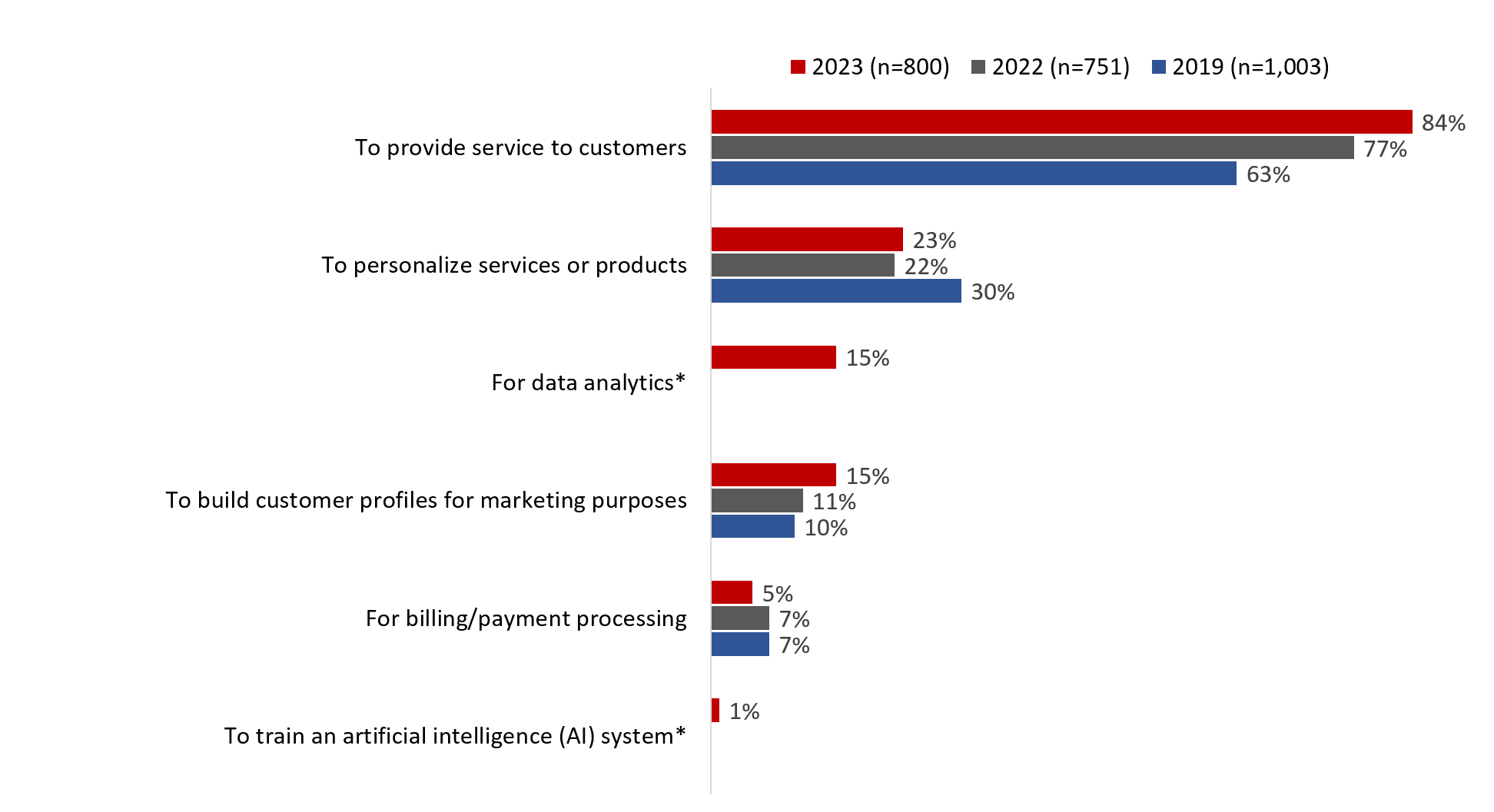
Q3. What does your company do with the personal information that it collects about customers? Is it used...? Multiple responses accepted. Base: all respondents. *New categories this year.
Text version of Figure 1
Figure 1: Use of customer information collected by companies
| 2019 (n=1,003) | 2022 (n=751) | 2023 (n=800) | |
|---|---|---|---|
| To train an artificial intelligence (AI) system* | - | - | 1% |
| For billing/payment processing | 7% | 7% | 5% |
| To build customer profiles for marketing purposes | 10% | 11% | 15% |
| For data analytics* | - | - | 15% |
| To personalize services or products | 30% | 22% | 23% |
| To provide service to customers | 63% | 77% | 84% |
Companies selling to other businesses, or to both business and consumers, were significantly more likely than companies selling only to consumers to report using customers’ personal information to provide service (94% and 89%, respectively) compared to 63% of businesses selling directly to consumers).
Many companies store personal information on-site electronically
Canadian businesses reported using a variety of methods to store customers’ personal information. Consistent with previous years, on-site electronic storage topped the list, mentioned by 68% of survey business representatives (up from 62% in 2022). Following on-site electronic storage, 41% of business representatives said their company stores customers’ personal information off-site with a third-party, such as a cloud serviceFootnote 1. Use of third parties for electronic storage has increased significantly this year, from 27% in 2022 to 41% in 2023. Finally, almost as many (38%; virtually unchanged from 41% in 2022) respondents said their company stores this information on-site on paper.
In addition to storing information on-site or via a third party, a number of companies said this information is stored electronically (15%), or on paper (7%), at employees’ or employers’ home offices.
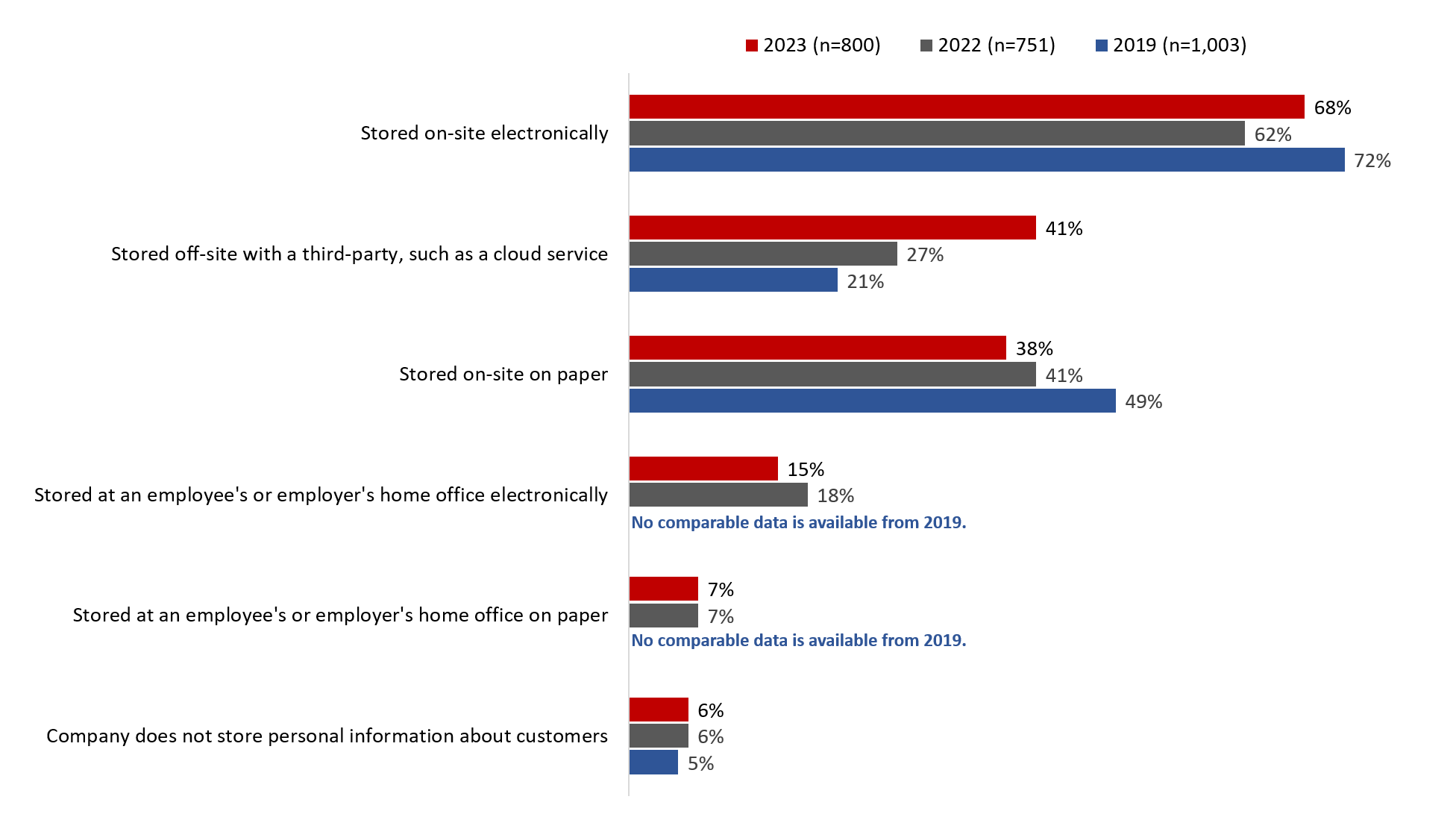
Q4. How does your company store the personal information of customers? Is the information…? Multiple responses accepted. Base: all respondents.
Text version of Figure 2
Figure 2: Methods used by companies to store personal information
| 2019 (n=1,003) | 2022 (n=751) | 2023 (n=800) | |
|---|---|---|---|
| Company does not store personal information about customers | 5% | 6% | 6% |
| Stored at an employee’s or employer’s home office on paper | 0% No comparable data is available from 2019. | 7% | 7% |
| Stored at an employee’s or employer’s home office electronically | 0% No comparable data is available from 2019. | 18% | 15% |
| Stored on-site on paper | 49% | 41% | 38% |
| Stored off-site with a third-party, such as a cloud service | 21% | 27% | 41% |
| Stored on-site electronically | 72% | 62% | 68% |
Businesses in western Canada (79%) were the most likely to store customers’ personal information on-site electronically. In addition, the likelihood of storing data on-site electronically increased with business size, from 48% of sole proprietorships to 74% of businesses with 20 or more employees. Large (17%) and small (15%) businesses were more likely than medium-sized businesses (7%) to store customers’ personal information electronically at an employee’s or employers’ home office.
The likelihood of using a third-party for storage, such as a cloud service, was higher in Atlantic Canada (57%), Ontario (45%) and western Canada (43%) compared to Quebec (24%), as well as among companies that sell to businesses only (47%) or to businesses and consumers (45%) compared to those that sell exclusively to consumers (28%). Use of third-party storage services also tended to be higher among companies operating in core industries or sectors of the economyFootnote 2, such as professional, scientific and technical services, finance and insurance, information and cultural industries, and arts, entertainment and recreation.
Very few companies send customer information outside Canada
Three percent of surveyed business representatives said their company sends customers’ personal information to companies outside Canada for processing, storage, or other purposes. The vast majority (95%) do not.
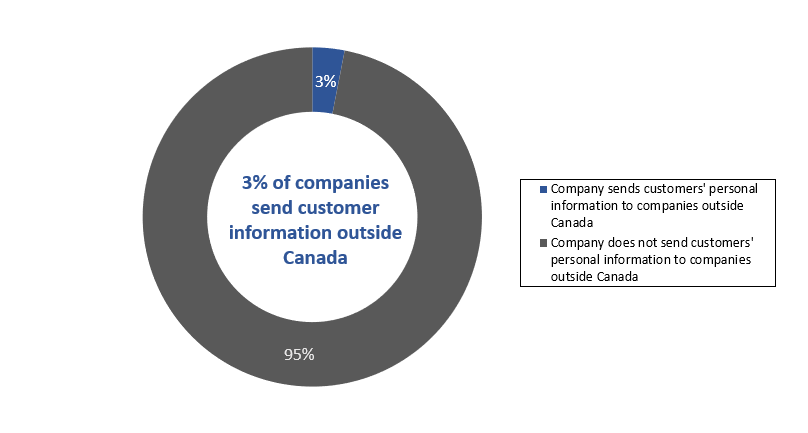
Q5. Does your company send customers’ personal information to companies outside Canada for processing, storage or other purposes? Base: n=800; all respondents. Don’t know: 2%
Text version of Figure 3
Figure 3: Cross-border movement of customers’ personal information
| % of respondents | |
|---|---|
| Company sends customers’ personal information to companies outside Canada | 3% |
| Company does not send customers’ personal information to companies outside Canada | 95% |
3% of companies send customer information outside Canada
Among companies that send customers’ personal information outside Canada (n=26)Footnote 3, two-thirds (67%) of the business representatives surveyed said their company informs customers that their personal information may leave Canada. The rest of the companies do not do this, or the respondent did not know. Companies that inform customers (n=13)Footnote 2 are most likely to use the corporate privacy policy to inform customers, followed by the Terms of Service agreement and, finally, express consent.
2. Technology
Limited use of AI for business operations
Six percent of business representatives surveyed reported that their company uses AI for business operations. The vast majority (93%) do not.
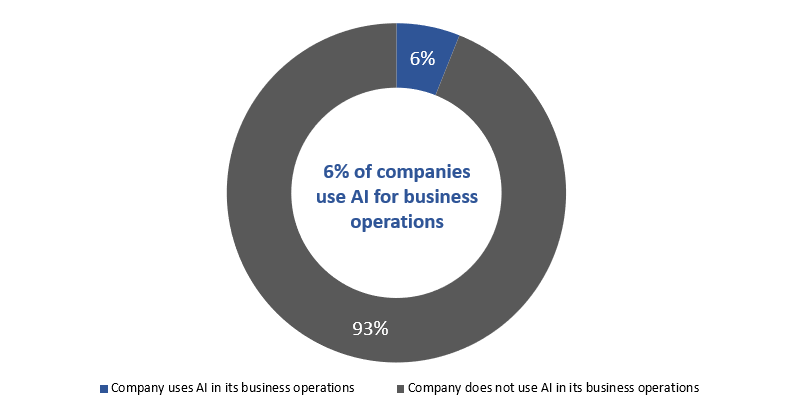
Q8. Does your company use AI for business operations? Base: n=800; all respondents. Don’t know: 1%
Text version of Figure 4
Figure 4: Use of AI for business operations
| % of respondents | |
|---|---|
| Company uses AI in its business operations | 6% |
| Company does not use AI in its business operations | 93% |
6% of companies use AI for business operations
Improve business operations – top use for AI
Among companies that use AI for business operations (n=39)Footnote 4, the majority (61%) are using it to improve business operations.
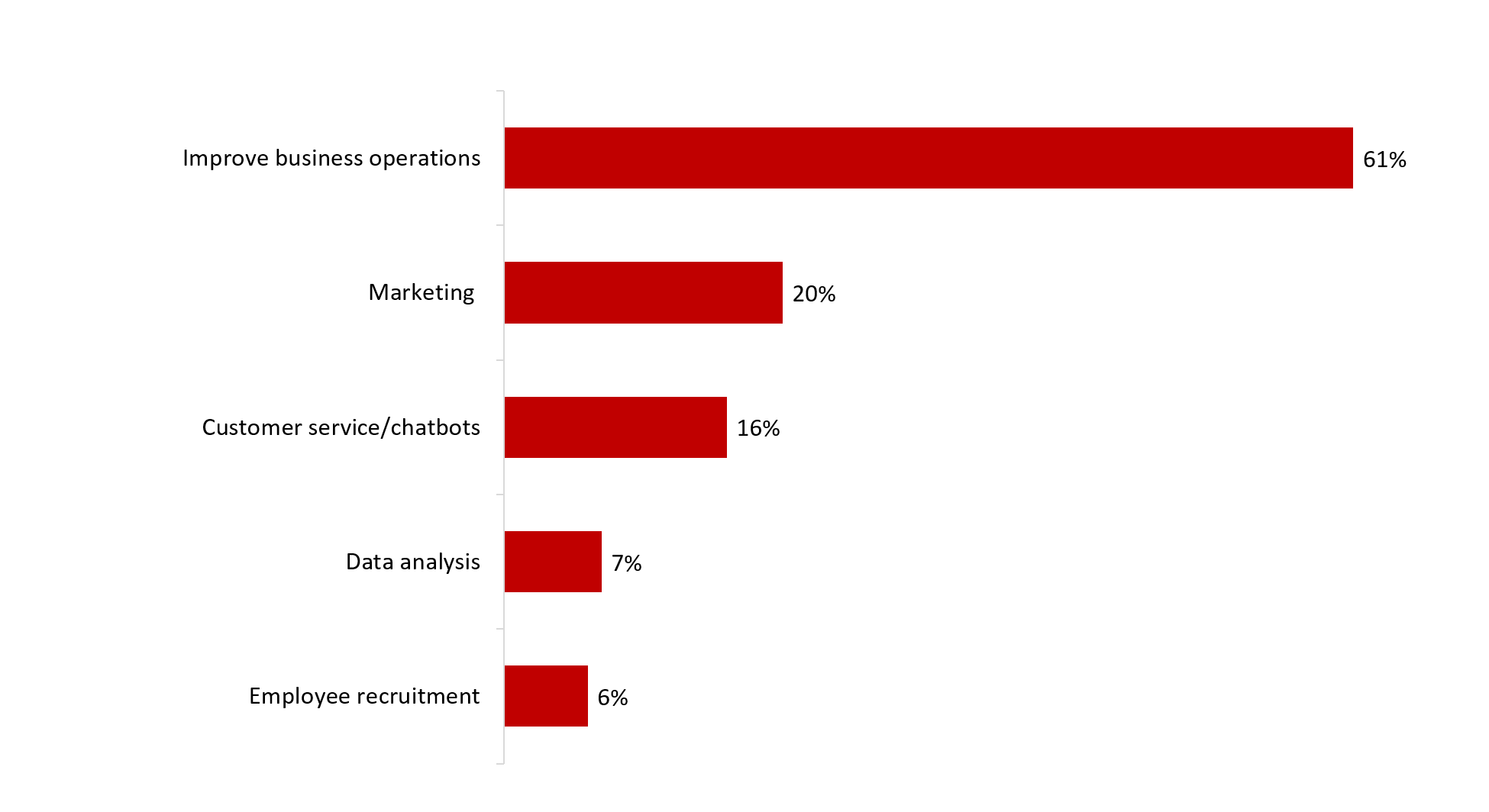
Q9. How is your company using AI in its business operations? Multiple responses accepted Base: n=39; those using AI in their business operations. Don’t know: <1%.
Text version of Figure 5
Figure 5: How AI is used in business operations
| % of respondents | |
|---|---|
| Employee recruitment | 6% |
| Data analysis | 7% |
| Customer service/chatbots | 16% |
| Marketing | 20% |
| Improve business operations | 61% |
4 in 10 use AI to improve efficiency and to make decisions
Four in ten (41%) respondents who reported that their company uses AI in its business operations said AI is being used to improve efficiency and for decision-makingFootnote 5. Almost as many (39%) said their company is using AI to improve efficiency but not for decision-making. Few companies are currently using AI for decision-making but not to improve efficiency. Just over one in 10 (12%) surveyed business representatives said their company is using AI in business operations for neither of these purposes.
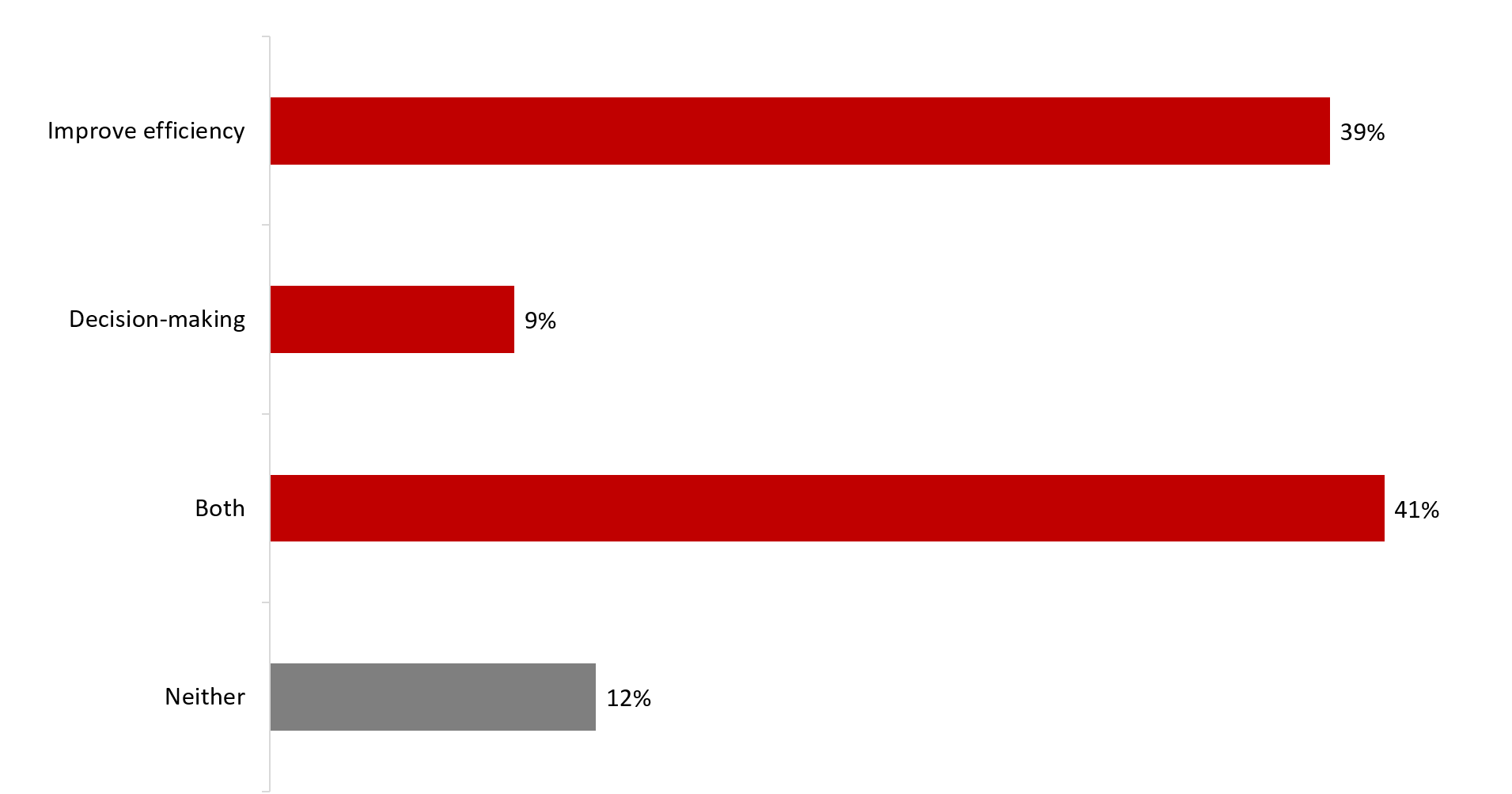
Q10. Is AI being used by your company to improve efficiency, for decision-making, or for both? Base: n=39; those using AI in their business operations. Don’t know: <1%
Text version of Figure 6
Figure 6: What AI is being used for by companies
| % of respondents | |
|---|---|
| Neither | 12% |
| Both | 41% |
| Decision-making | 9% |
| Improve efficiency | 39% |
One-quarter of companies not using AI are somewhat or very likely to do so in the next 5 years
Nearly one-quarter of those surveyed who said their company does not currently use AI (n=761) reported that it is somewhat (16%) or very (7%) likely that their company will use AI for business operations in the next five years. In contrast, just over three-quarters of respondents said it is not very (26%) or not at all (51%) likely that their company will use AI in the next five years.
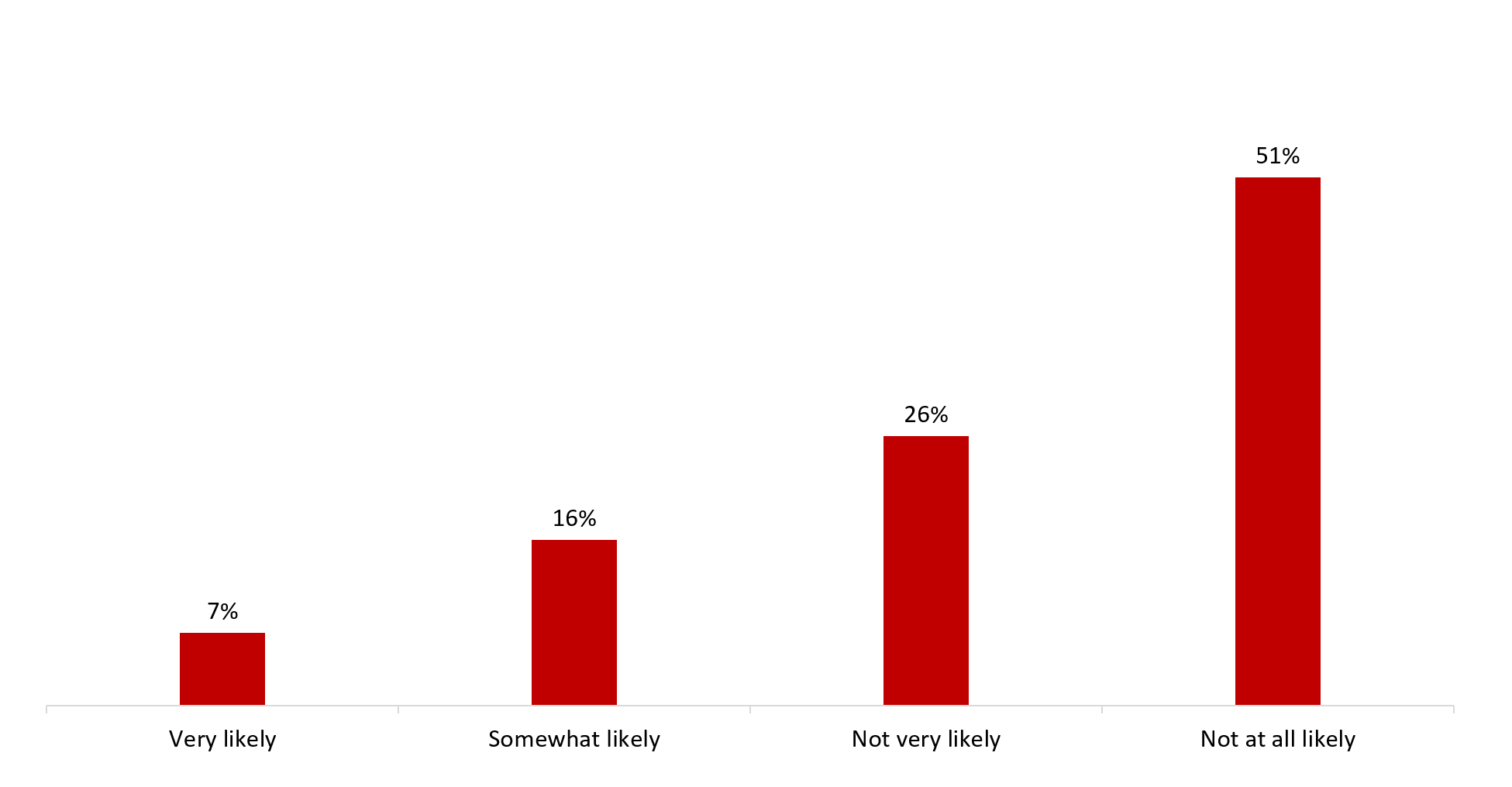
Q12. How likely is it that your company will use AI for business operations in the next five years? Base: n=761; those who do not currently use AI for business operations. Don’t know: <1%
Text version of Figure 7
Figure 7: Likelihood of using AI for business operations in the next 5 years
| % of respondents | |
|---|---|
| Not at all likely | 51% |
| Not very likely | 26% |
| Somewhat likely | 16% |
| Very likely | 7% |
3. Canada’s privacy laws and compliance
This section examines findings regarding companies’ awareness of their responsibilities under privacy laws. Questions in this section were prefaced with the following description of Canada’s privacy laws:
The federal government’s privacy law, the Personal Information Protection and Electronic Documents Act or PIPEDA,sets out rules that govern how businesses engaged in commercial activities should protect personal information. In Alberta, BC and Quebec, the private sector is governed by provincial laws, which are considered to be similar to the federal law.
Many companies have a high level of awareness of their responsibilities under privacy laws
Almost half of business representatives (47%) said their company is highly aware of its responsibilities under Canada’s privacy laws (scores of 6 or 7 on the 7-point scale), while 41% rated their company as moderately aware (scores of 3 to 5). Taken together, the majority (88%) of surveyed companies are at least moderately aware of their privacy-related responsibilities. Few (12%) rated their company’s awareness as low (scores of 1 or 2).
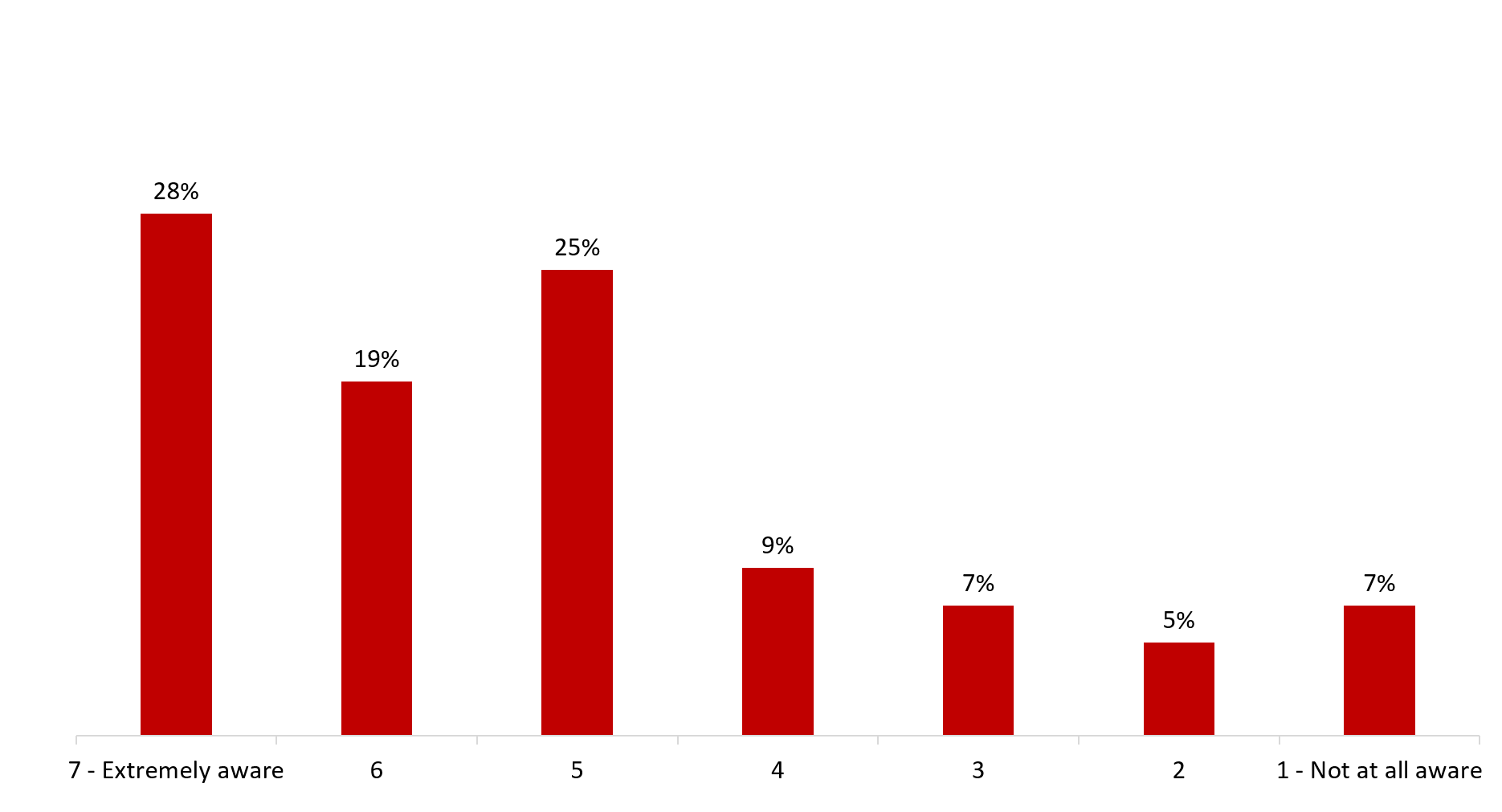
Q13. How would you rate your company’s awareness of its responsibilities under Canada’s privacy laws? Base: n=800; all respondents. Don’t know: 1%.
Text version of Figure 8
Figure 8: Companies’ awareness of responsibilities under privacy laws
| % of respondents | |
|---|---|
| 7 - Extremely aware | 28% |
| 6 | 19% |
| 5 | 25% |
| 4 | 9% |
| 3 | 7% |
| 2 | 5% |
| 1 - Not at all aware | 7% |
Awareness was higher among companies based in Quebec (65%) compared to those in Atlantic Canada (36%), Ontario (45%) and western Canada (43%) and it increased with company size, from 45% of small businesses to 77% of large businessesFootnote 6. In addition, awareness was higher among companies that have taken steps to ensure it complies with Canada’s privacy laws (58% versus 11% of those that have not), collect personal information from minors (69% versus 45% of those that do not), have a privacy policy (59% versus 31% of those that do not), and are aware of the OPC’s resources for businesses (65% versus 35% of those that are not).
The proportion of business representatives who said their company is highly aware of its responsibilities under Canada’s privacy laws continues to decline from the high of 57% reported in 2019. This year, 47% (a decline of 5%) felt their company is highly aware of its privacy-related responsibilities compared to 52% in 2022.
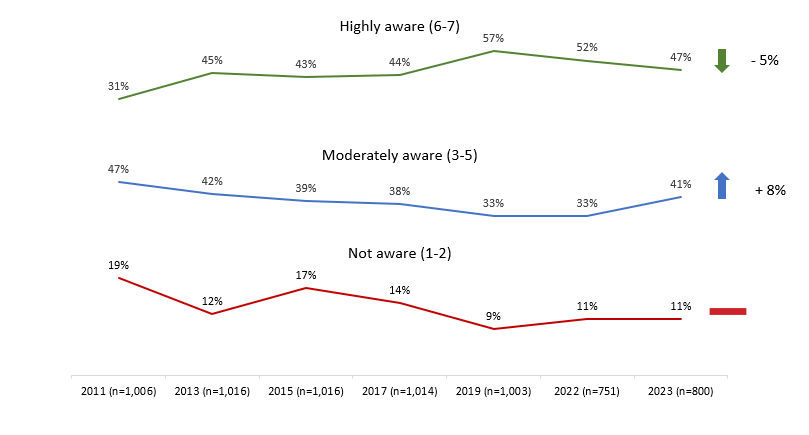
Net calculations are based on unrounded percentages.
Q13. How would you rate your company’s awareness of its responsibilities under Canada’s privacy laws?
Text version of Figure 9
Figure 9: Companies’ awareness of responsibilities under privacy laws [2011-present]
| Highly aware (6-7) | |
|---|---|
| 2011 (n=1,006) | 31% |
| 2013 (n=1,016) | 45% |
| 2015 (n=1,016) | 43% |
| 2017 (n=1,014) | 44% |
| 2019 (n=1,003) | 57% |
| 2022 (n=751) | 52% |
| 2023 (n=800) | 47% |
| Moderately aware (3-5) | |
|---|---|
| 2011 (n=1,006) | 47% |
| 2013 (n=1,016) | 42% |
| 2015 (n=1,016) | 39% |
| 2017 (n=1,014) | 38% |
| 2019 (n=1,003) | 33% |
| 2022 (n=751) | 33% |
| 2023 (n=800) | 41% |
| Not aware (1-2) | |
|---|---|
| 2011 (n=1,006) | 19% |
| 2013 (n=1,016) | 12% |
| 2015 (n=1,016) | 17% |
| 2017 (n=1,014) | 14% |
| 2019 (n=1,003) | 9% |
| 2022 (n=751) | 11% |
| 2023 (n=800) | 11% |
Three-quarters have taken steps to comply with privacy laws
Three-quarters (76%) of business representatives surveyed said their company has taken steps to ensure it complies with Canada’s privacy laws. Compliance has not changed in any significant way since 2019, and it remains higher than the baseline of 66% reported in 2017.
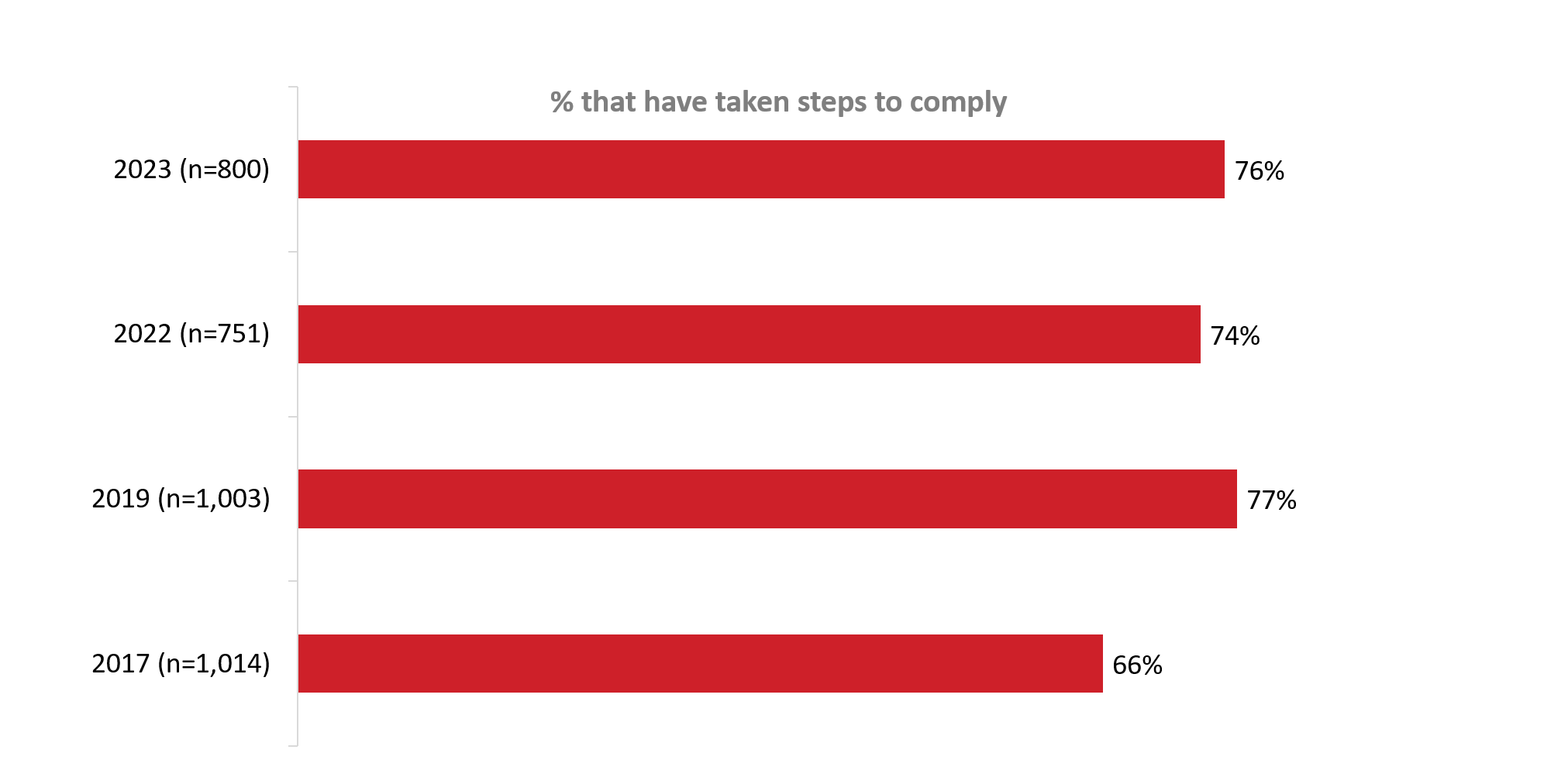
Q14. Has your company taken steps to ensure it complies with Canada’s privacy laws? Base: all respondents.
Text version of Figure 10
Figure 10: Compliance with Canada’s privacy laws
| % that have taken steps to comply | |
|---|---|
| 2017 (n=1,014) | 66% |
| 2019 (n=1,003) | 77% |
| 2022 (n=751) | 74% |
| 2023 (n=800) | 76% |
The likelihood of taking steps to ensure compliance increased with the size of the company, from 75% of small businesses to 94% of large businesses. In addition, it was higher among companies that currently use AI in their business operations (99% versus 75% of those that are not), collect personal information from minors (91% versus 75% of those that do not), have a privacy policy (92% versus 55% of those that do not), and are aware of the OPC’s resources for businesses (90% versus 67% of those that are not).
Most companies found it at least somewhat easy to ensure compliance
Among companies that have taken steps to comply with Canada’s privacy laws (n=623), more than nine in 10 (93%) found it moderately (scores of 3 to 5 on a 7-point scale) or extremely (scores of 1 and 2) easy to bring their personal information handling practices into compliance. Very few business representatives (5%) said their company faced significant difficulties (scores of 6 and 7) ensuring compliance with Canada’s privacy laws.
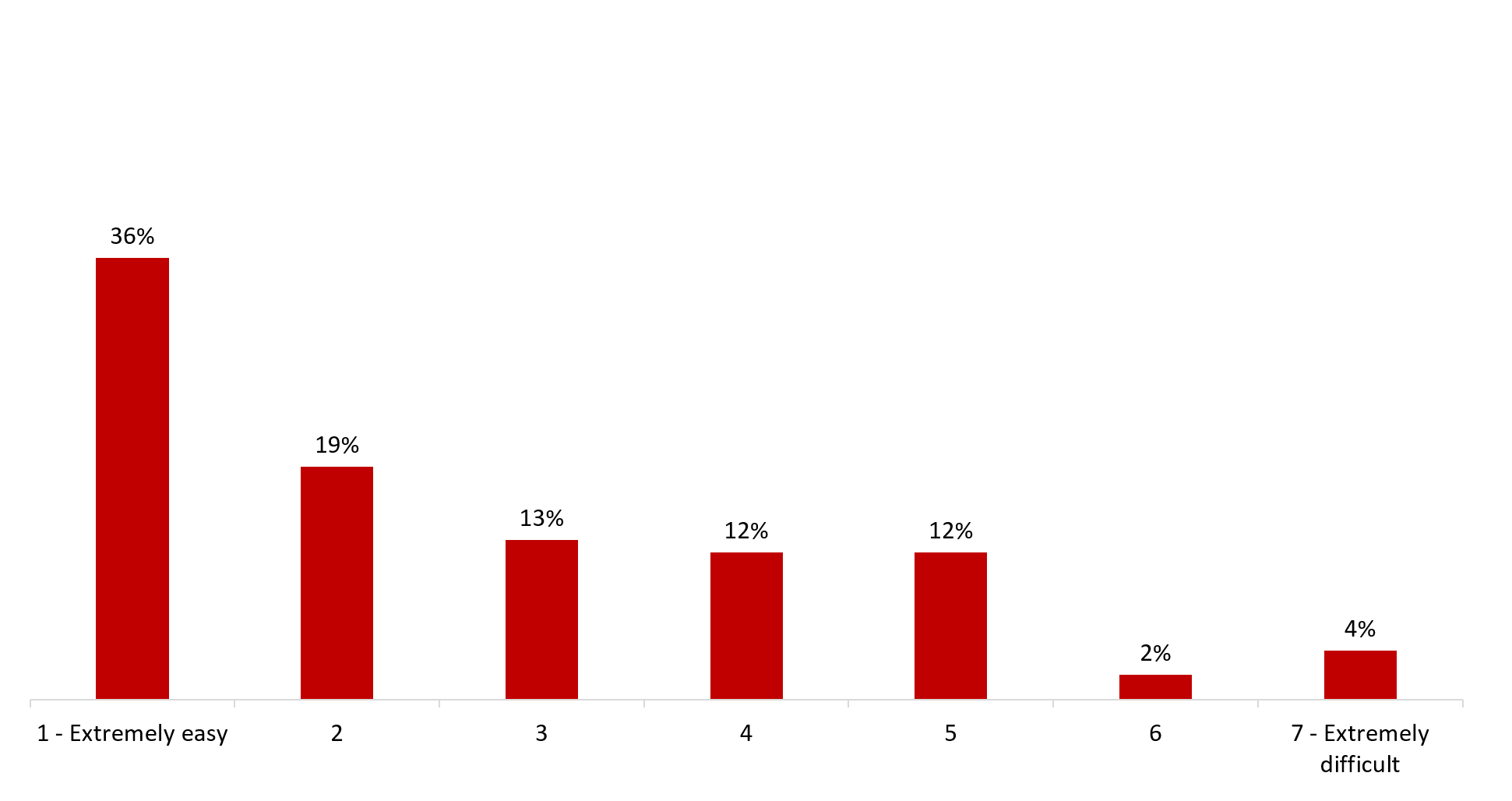
Q15. How difficult has it been for your company to bring your personal information handling practices into compliance with Canada’s privacy laws? Base: n=623; those who have taken steps to comply with Canadian privacy laws. Don’t know: 2%.
Text version of Figure 11
Figure 11: Level of difficulty complying with Canada’s privacy laws
| % of respondents | |
|---|---|
| 7 - Extremely difficult | 4% |
| 6 | 2% |
| 5 | 12% |
| 4 | 12% |
| 3 | 13% |
| 2 | 19% |
| 1 - Extremely easy | 36% |
Small businesses (57%) were more likely to find it easy to comply with Canada’s privacy laws as compared to larger businesses (46% of businesses with 20 to 99 employees and 42% of businesses with 100 or more employees).
The proportion of companies that found it very easy to bring personal information handling practices into compliance with Canada’s privacy laws has increased significantly this year to a high of 56% (from 35% in 2022 and 37% in 2019).
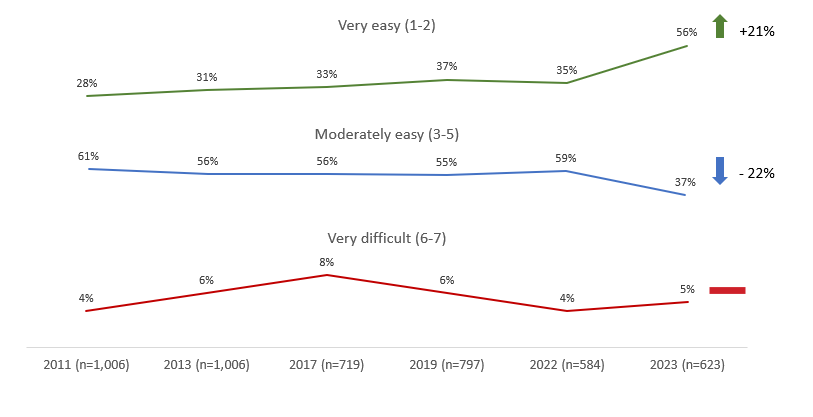
Net calculations are based on unrounded percentages.
Q15. How difficult has it been for your company to bring your personal information handling practices into compliance with Canada’s privacy laws?
Text version of Figure 12
Figure 12: Compliance with Canada’s privacy laws [2011-present]
| Extremely easy (1-2) | |
|---|---|
| 2011 (n=1,006) | 28% |
| 2013 (n=1,006) | 31% |
| 2017 (n=719) | 33% |
| 2019 (n=797) | 37% |
| 2022 (n=584) | 35% |
| 2023 (n=623) | 56% |
| Moderately easy (3-5) | |
|---|---|
| 2011 (n=1,006) | 61% |
| 2013 (n=1,006) | 56% |
| 2017 (n=719) | 56% |
| 2019 (n=797) | 55% |
| 2022 (n=584) | 59% |
| 2023 (n=623) | 37% |
| Extremely difficult (6-7) | |
|---|---|
| 2011 (n=1,006) | 4% |
| 2013 (n=1,006) | 6% |
| 2017 (n=719) | 8% |
| 2019 (n=797) | 6% |
| 2022 (n=584) | 4% |
| 2023 (n=623) | 5% |
Few challenges were identified when it comes to complying with Canada’s privacy laws
Nearly two-thirds (64%) of business representatives said their company did not have or does not expect to face any specific challenges when complying with Canada’s privacy laws. When asked in an open-ended manner to identify challenges encountered or anticipated, these respondents explained that it just “seemed/seems difficult”. An additional 16% said they did not know about any challenges.
Specific challenges included lack of knowledge (6%) or understanding of privacy laws (6%), difficulty integrating privacy measures with existing systems/processes (5%), lack of internal resources or a dedicated privacy team (4%), lack of technical skills (2%), and the financial cost of compliance (2%).
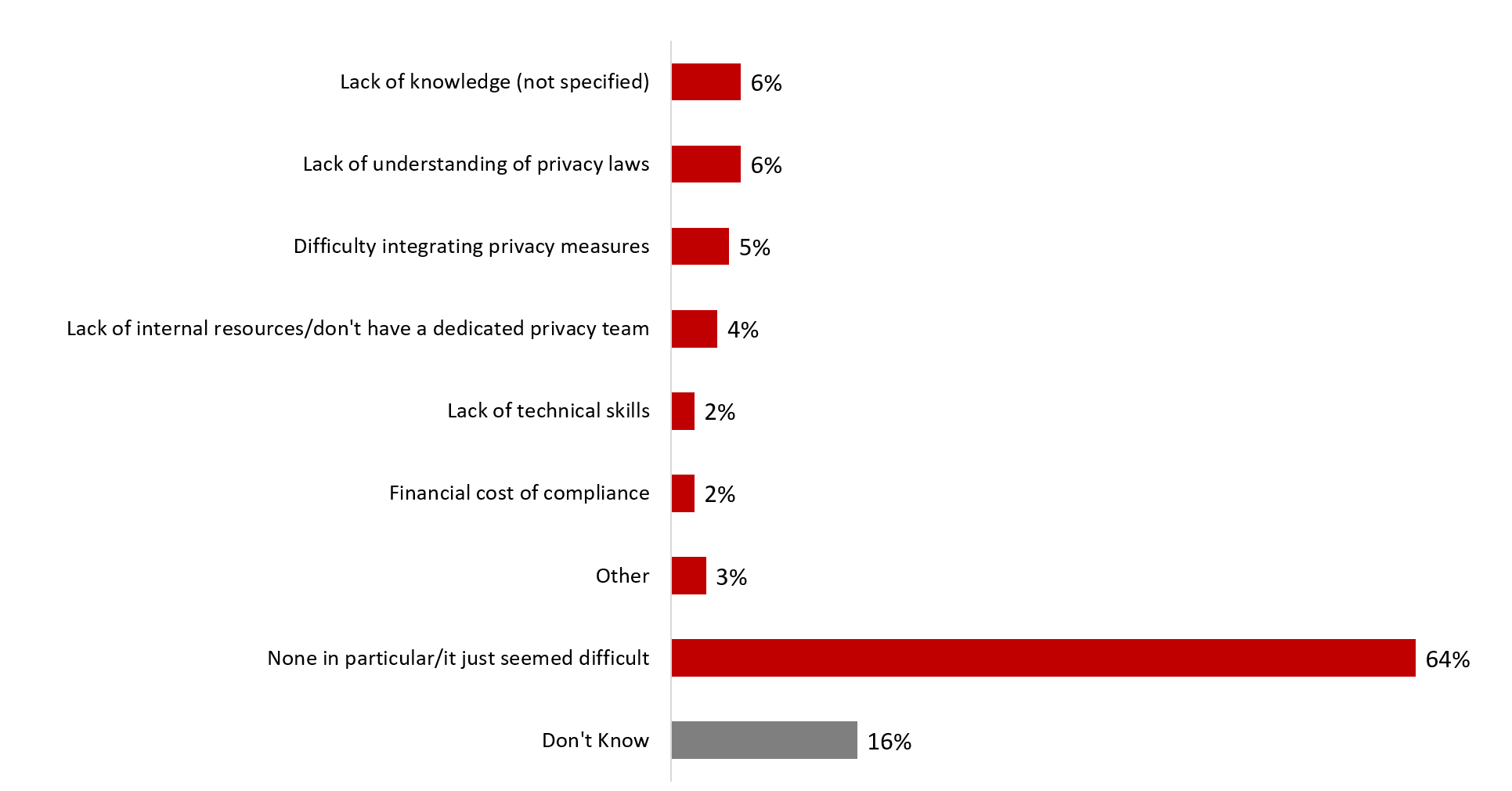
Q16. What challenges, if any, did your company have / do you expect your company will face complying with Canada’s privacy laws? Multiple responses accepted. Base: n=800; all respondents.
Text version of Figure 13
Figure 13: Challenges complying with Canada’s privacy laws
| % of respondents | |
|---|---|
| Don’t Know | 16% |
| None in particular/it just seemed difficult | 64% |
| Other | 3% |
| Financial cost of compliance | 2% |
| Lack of technical skills | 2% |
| Lack of internal resources/don’t have a dedicated privacy team | 4% |
| Difficulty integrating privacy measures | 5% |
| Lack of understanding of privacy laws | 6% |
| Lack of knowledge (not specified) | 6% |
Half have looked for information about privacy responsibilities
Half (49%) of companies have looked for information about their responsibilities under Canada’s privacy laws. Forty-four percent have not (7% of surveyed business representatives did not know whether their company had looked for this type of information).
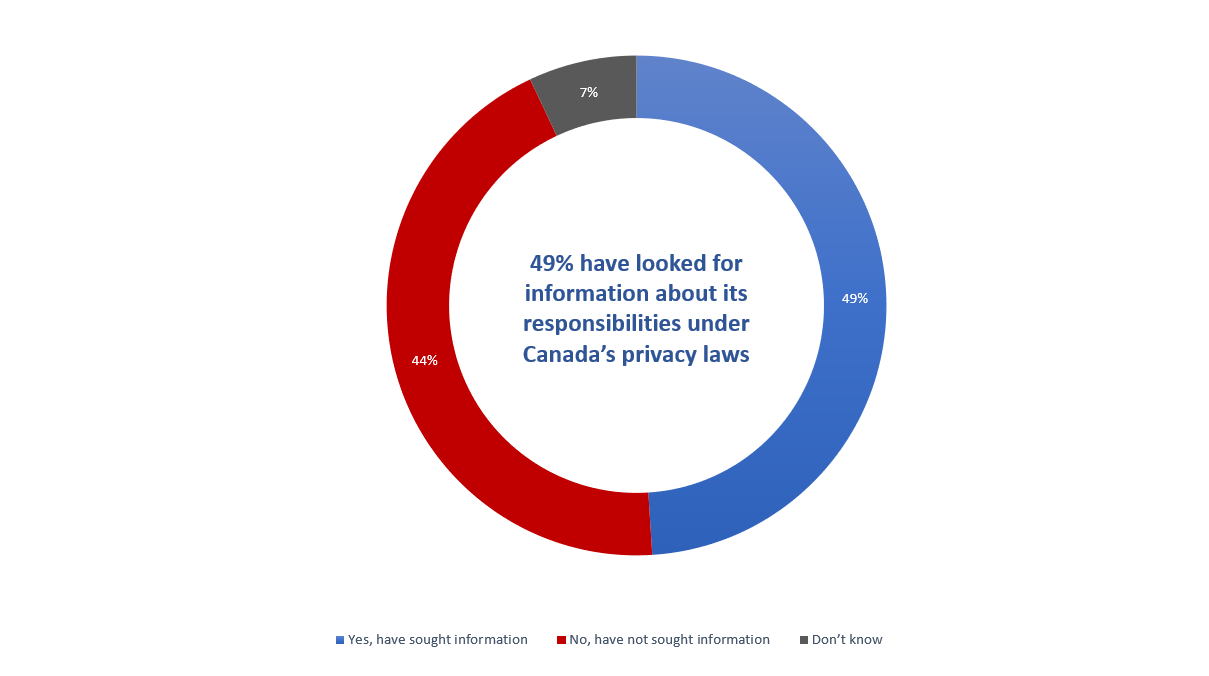
Q17. Has your company ever looked for information about its responsibilities under Canada’s privacy laws? Base: n=800; all respondents.
Text version of Figure 14
Figure 14: Sought information about privacy responsibilities
| % of respondents | |
|---|---|
| Yes, have sought information | 49% |
| No, have not sought information | 44% |
| Don’t know | 7% |
49% have looked for information about its responsibilities under Canada’s privacy laws
Compared to companies in Atlantic Canada (30%), those in Quebec (53%) and Ontario (52%) were more likely to have looked for information about their responsibilities under Canada’s privacy laws. Additionally, the likelihood of looking for information increased with business size, from 47% of small businesses to 72% of large businesses, and with knowledge of privacy-related responsibilities, from 15% of companies unaware of these responsibilities to 63% of those highly aware. Companies that are currently using AI (86% versus 46% of those that are not), have taken steps to comply with privacy laws (60% versus 12% of those that have not), and are aware of the OPC’s resources for business (57% versus 43% of those that are not) were more likely to have looked for information about Canada’s privacy laws.
Internet followed by the government are the top sources of information
If business representatives needed information about their company’s responsibilities under Canada’s privacy laws, the top source of information would be the Internet (30%) and the Government of Canada (27%), followed by Google or other online search engines (23%). In addition to the Government of Canada, 10% said they would look to government, but did not specify which jurisdiction, while 7% mentioned their provincial or territorial government, 4% the Office of the Privacy Commissioner of Canada, and 1% their provincial or territorial privacy commissioner.
Beyond the Internet and government, 8% said they would ask a colleague or their corporate or head office for information, 7% their industry or professional association, 5% industry experts or consulting firms, 4% other types of professionals, such as accountants or lawyers, and 2% a privacy expert.
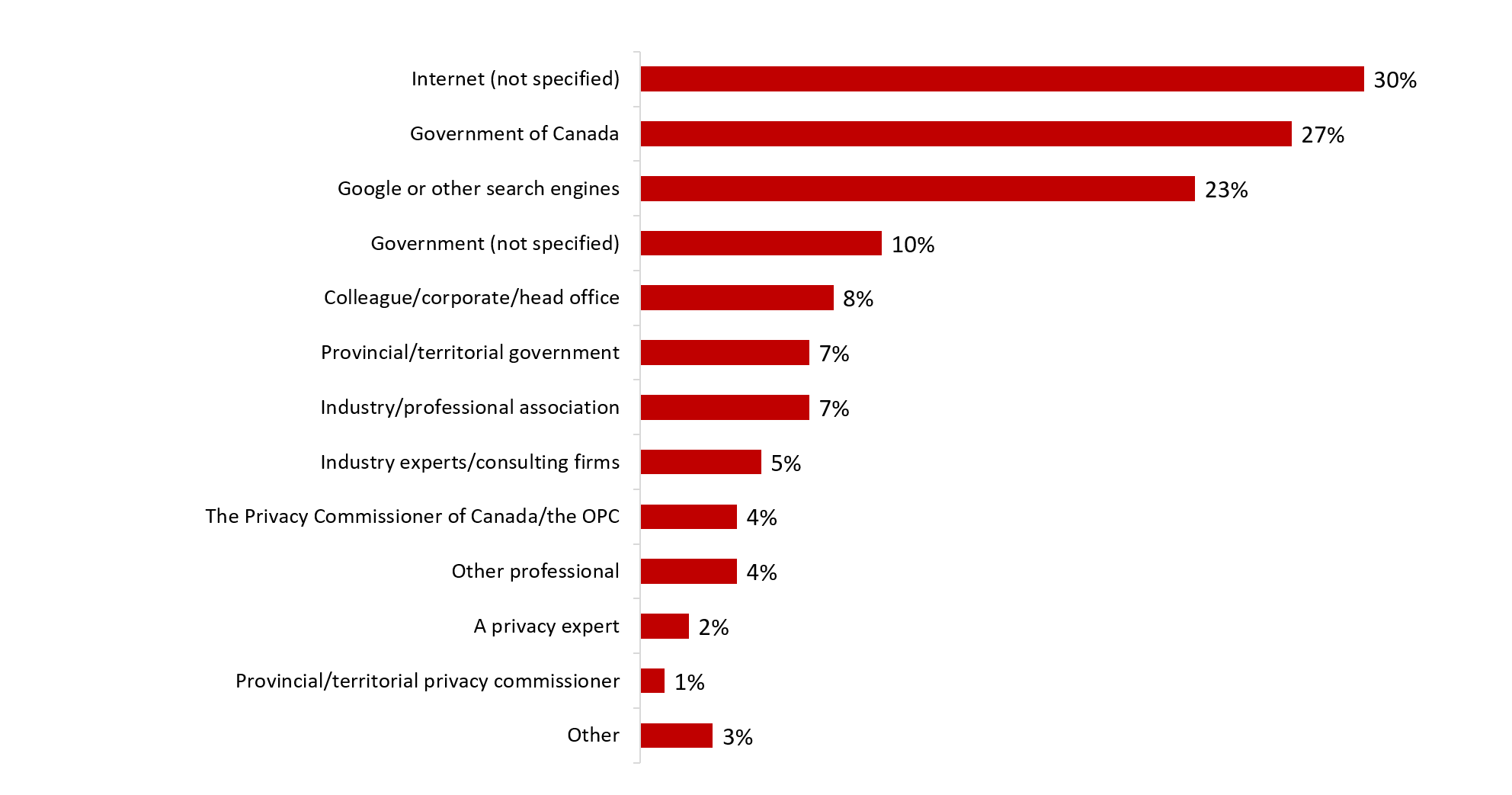
Q18. If you needed information about your company’s responsibilities under Canada’s privacy laws, where would you look? Multiple responses accepted. Base: n=800; all respondents. Don’t know: 4%
Text version of Figure 15
Figure 15: Sources of information about privacy-related responsibilities
| % of respondents | |
|---|---|
| Other | 3% |
| Provincial/territorial privacy commissioner | 1% |
| A privacy expert | 2% |
| Other professional | 4% |
| The Privacy Commissioner of Canada/the OPC | 4% |
| Industry experts/consulting firms | 5% |
| Industry/professional association | 7% |
| Provincial/territorial government | 7% |
| Colleague/corporate/head office | 8% |
| Government (not specified) | 10% |
| Google or other search engines | 23% |
| Government of Canada | 27% |
| Internet (not specified) | 30% |
4 in 10 aware of OPC’s resources
Four in 10 (41%) surveyed business representatives are aware that the OPC has information and tools to help companies comply with their privacy obligations. Awareness of OPC’s resources for businesses has increased significantly since 2021, when exactly one-third (33%) of respondents were aware.
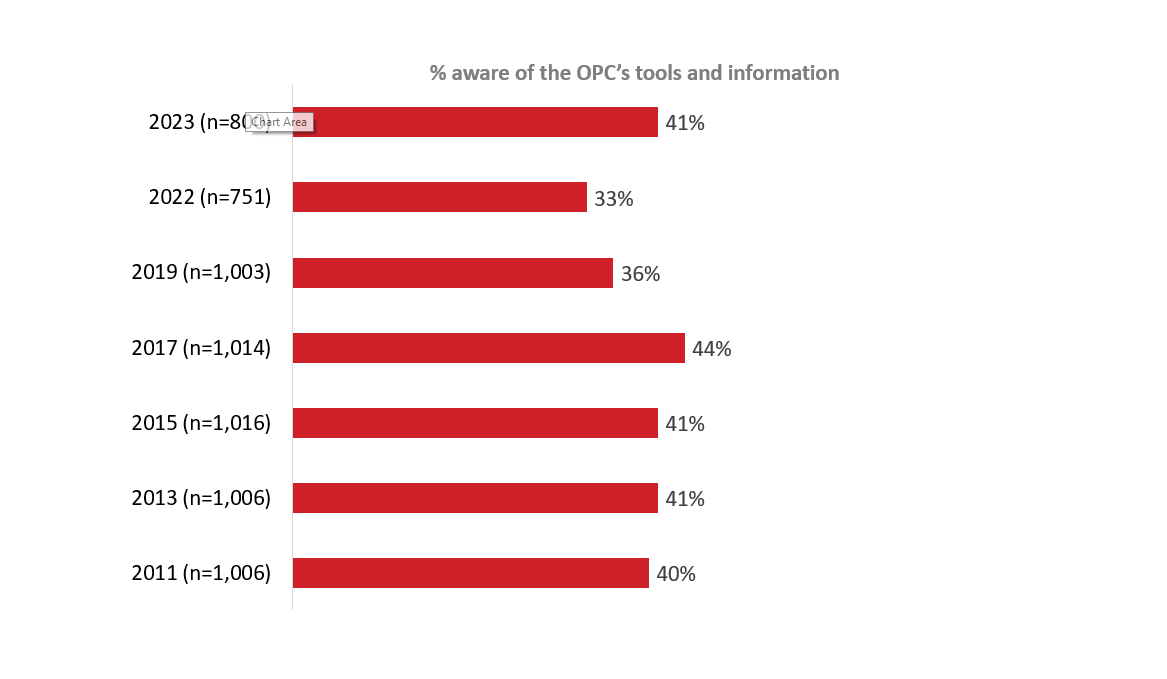
Q19. Are you aware that the Office of the Privacy Commissioner of Canada has information and tools available to companies to help them comply with their privacy obligations? Base: n=800 all respondents.
Text version of Figure 16
Figure 16: Awareness of OPC resources [2011-present]
| % aware of the OPC’s tools and information | |
|---|---|
| 2011 (n=1,006) | 40% |
| 2013 (n=1,006) | 41% |
| 2015 (n=1,016) | 41% |
| 2017 (n=1,014) | 44% |
| 2019 (n=1,003) | 36% |
| 2022 (n=751) | 33% |
| 2023 (n=800) | 41% |
The likelihood of being aware that the OPC has information and tools available to companies to help them comply with privacy laws in Canada increased with business size, from 40% of small businesses to 59% of large businesses, and with knowledge of privacy-related responsibilities, from 24% of companies unaware of these responsibilities to 56% of those highly aware. Awareness was also higher among companies that have taken steps to comply with privacy-related obligations (48% versus 19% of that have not).
1 in 4 companies have used OPC’s resources
One in four (26%) respondents aware of the OPC’s resources (n=335) said their company has used the information and tools to help comply with privacy obligations. Compared to a decade ago, self-reported use of the OPC’s information and tools has increased significantly, from 17% in 2013 to 26% in 2023.
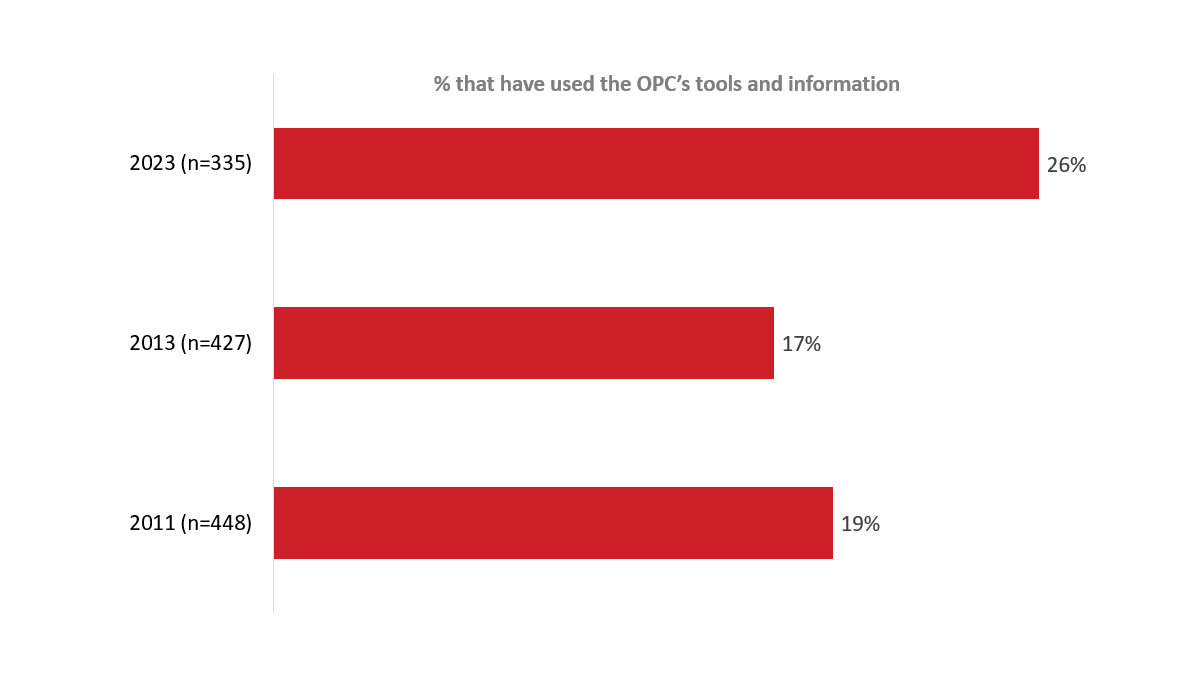
Q20. Has your company ever used any of these resources? Base: those aware of OPC tools and information.
Text version of Figure 17
Figure 17: Use of OPC resources [2011-present]
| % that have used the OPC’s tools and information | |
|---|---|
| 2011 (n=448) | 19% |
| 2013 (n=427) | 17% |
| 2023 (n=335) | 26% |
Use of the OPC’s resources increased with business size, from 22% of small businesses to 54% of large businesses.
Lack of need is the main reason for not using the OPC’s resources
Among those aware of the OPC’s resources who have not used them (n=405), the main reason offered was a lack of need. Three in 10 (31%) said lack of need specifically, 9% that they do not need help to comply, and 3% that their company has a dedicated privacy team. Following lack of need, two in 10 (21%) pointed to lack of awareness or knowledge that resources existed, 8% to their perception that the resources would not be relevant, and 3% to their perception that the resources would not be helpful.
Others offered no specific reason for never having used the OPC’s resources: 18% said there is no reason in particular and 11% did not know why their company has not used the information and tools.
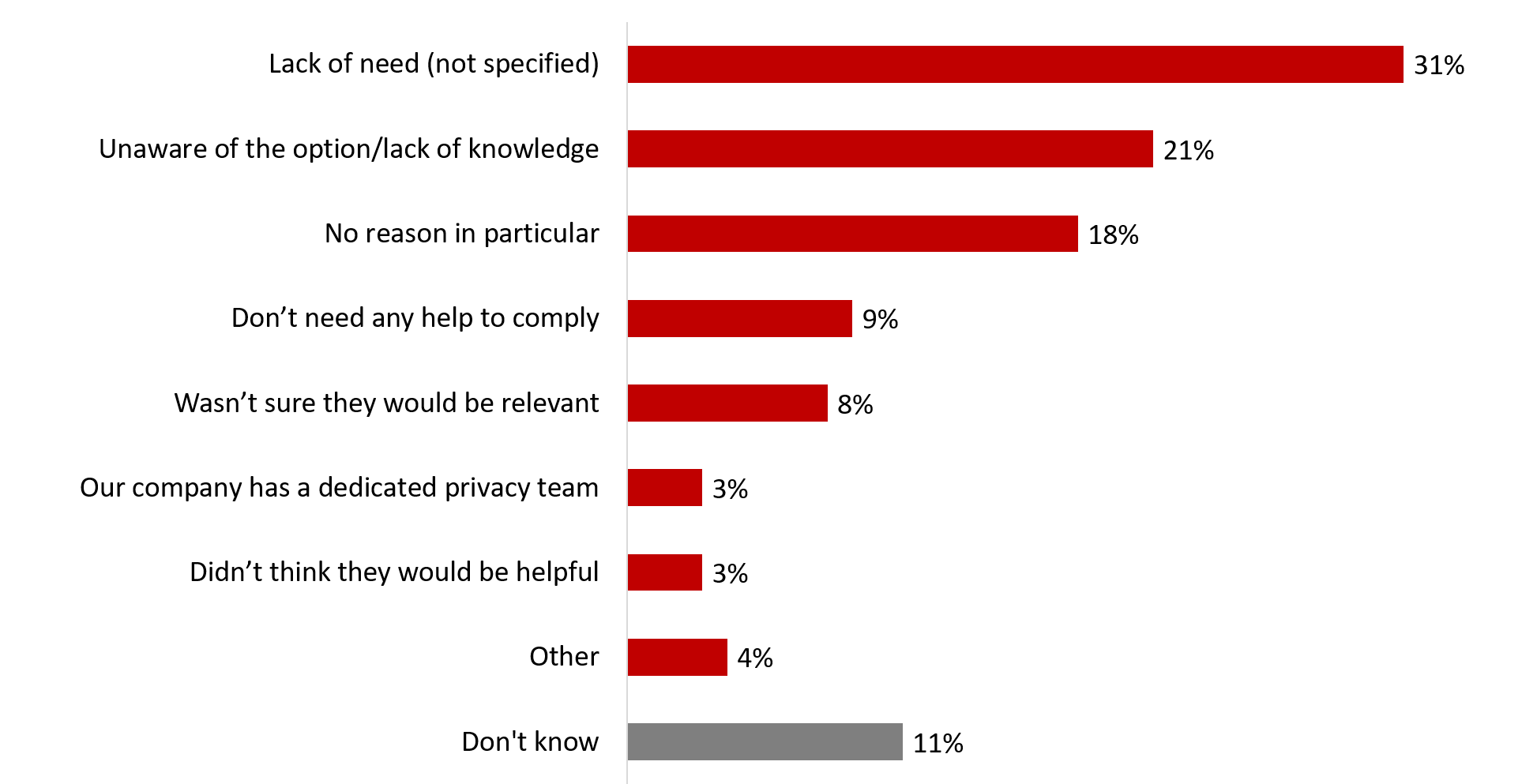
Q21. Is there a specific reason why your company has never used these resources? Multiple responses accepted. Base: n=405, those aware of OPC resources, but have not used any.
Text version of Figure 18
Figure 18: Reasons for not using the OPC resources
| % of respondents | |
|---|---|
| Don’t know | 11% |
| Other | 4% |
| Didn’t think they would be helpful | 3% |
| Our company has a dedicated privacy team | 3% |
| Wasn’t sure they would be relevant | 8% |
| Don’t need any help to comply | 9% |
| No reason in particular | 18% |
| Unaware of the option/lack of knowledge | 21% |
| Lack of need (not specified) | 31% |
4. Company privacy practices
This section identifies the procedures and policies companies have in place to protect the personal information they collect about their customers.
8 in 10 attribute high importance to protecting customers’ personal information
The vast majority (94%) of business representatives said their company considers the protection of customers’ personal information to be at least moderately important. Specifically, eight in 10 (80%) said their company considers the protection of customers’ personal information to be of high importance (scores of 6 and 7 on a 7-point scale), including nearly seven in 10 (69%) who said this is an extremely importantcorporate objective, and 14% who attribute moderate importance to this objective. At the other end of the scale, 6% of business representatives reported that protecting customers’ personal information is not an important corporate objective for their company (scores of 1 and 2).
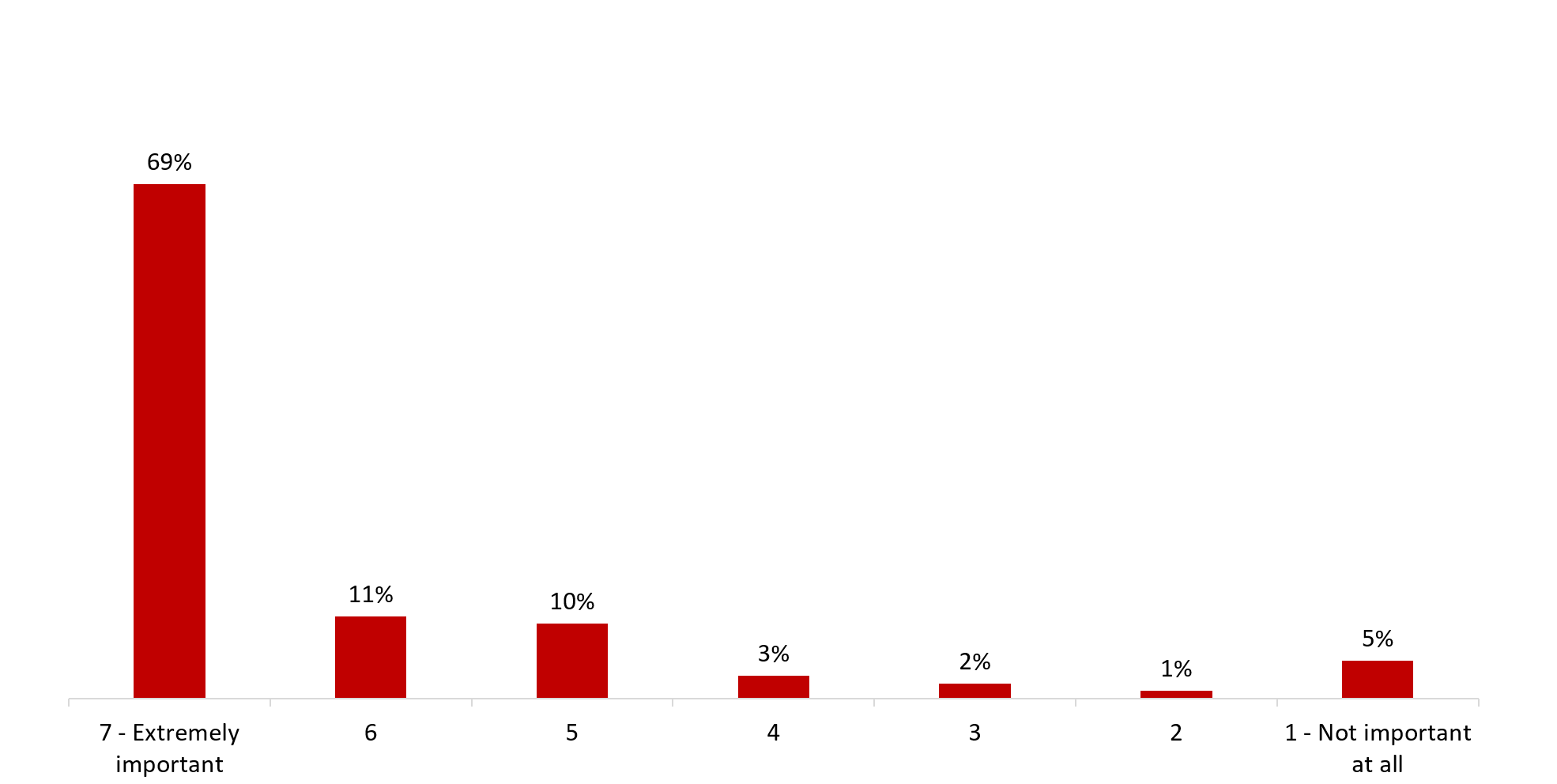
Q22. What importance does your company attribute to protecting your customers’ personal information? Base: n=800; all respondents. Don’t know: 1%
Text version of Figure 19
Figure 19: Importance attributed to protecting customers’ personal information
| % of respondents | |
|---|---|
| 7 - Extremely important | 69% |
| 6 | 11% |
| 5 | 10% |
| 4 | 3% |
| 3 | 2% |
| 2 | 1% |
| 1 - Not important at all | 5% |
Medium-sized (91%) and large (92%) companies were more likely than small companies (78%) to place a high level of importance (scores of 6 and 7) on the protection of customers’ personal information. In addition, companies that currently use AI (100% versus 78% of those that do not), that have taken steps to comply with Canada’s privacy laws (88% versus 50% of those that have not), and that collect information from minors (94% versus 78% of those that do not) also were more likely to view this as something that is highly important.
The proportion of companies that attribute importance to protecting customers’ personal information remains high and virtually unchanged since 2019: 81% in 2019, 79% in 2022, and 80% in 2023.
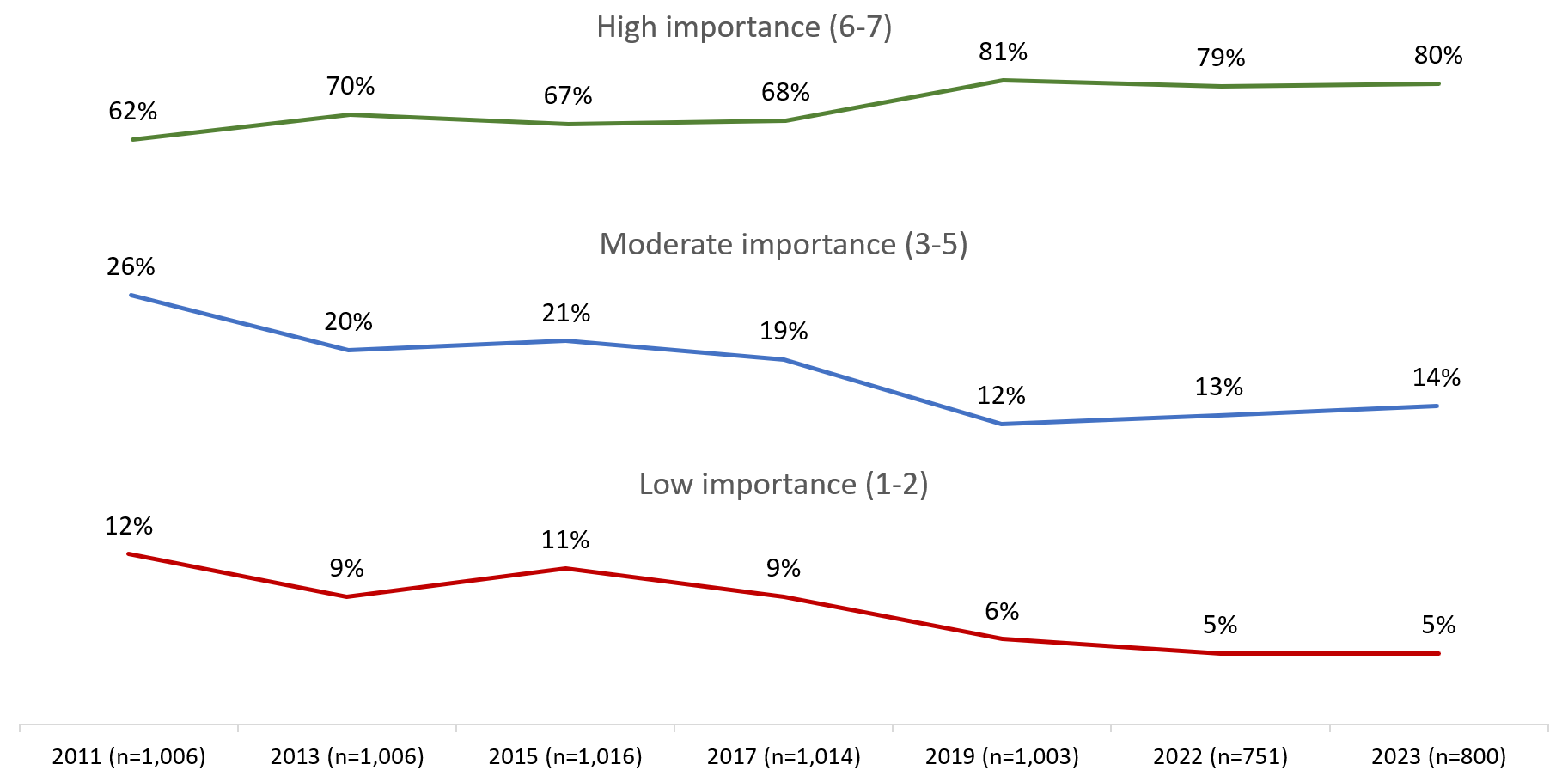
Net calculations are based on unrounded percentages.
Q22. What importance does your company attribute to protecting your customers’ personal information?
Text version of Figure 20
Figure 20: Net importance of protecting customers’ personal information [2011-present]
| High importance (6-7) | |
|---|---|
| 2011 (n=1,006) | 62% |
| 2013 (n=1,003) | 70% |
| 2015 (n=1,016) | 67% |
| 2017 (n=1,014) | 68% |
| 2019 (n=1,003) | 81% |
| 2022 (n=751) | 79% |
| 2023 (n=800) | 80% |
| Moderate importance (3-5) | |
|---|---|
| 2011 (n=1,006) | 26% |
| 2013 (n=1,006) | 20% |
| 2015 (n=1,016) | 21% |
| 2017 (n=1,014) | 19% |
| 2019 (n=1,003) | 12% |
| 2022 (n=751) | 13% |
| 2023 (n=800) | 14% |
| Low importance (1-2) | |
|---|---|
| 2011 (n=1,006) | 12% |
| 2013 (n=1,006) | 9% |
| 2015 (n=1,016) | 11% |
| 2017 (n=1,014) | 9% |
| 2019 (n=1,003) | 6% |
| 2022 (n=751) | 5% |
| 2023 (n=800) | 5% |
Half or more have implemented most privacy practices
Business representatives were asked whether their company has put in place a series of privacy practices. Half or more of respondents said their company has implemented the following privacy practices: designated a privacy officer (56%); put in place procedures for dealing with customer complaints about the handling of their personal information (53%) and for responding to customer requests for access to their personal information (50%); and developed and documented internal policies for staff that address privacy obligations (50%). Exactly one-third (33%) said their business regularly provides staff with privacy training and education.
A directional trend exists where the likelihood of having implemented many of the practices increased with company size. Regional differences were limited. Companies in western Canada (54%) were more likely than those in Quebec (40%) to have internal policies for staff, and companies in Ontario (59%) were more likely than those in Atlantic Canada (37%) and Quebec (45%) to have procedures in place for dealing with complaints from customers who feel that their information has been handled improperly.
Additionally, companies aware of the OPC’s resources to help companies comply with their privacy obligations were more likely than companies not aware to have implemented all of these privacy practices. Companies that collect personal information from minors were more likely than those that do not to have internal policies for staff that address privacy obligations (74% versus 47%), provide regular staff privacy training and education (58% versus 29%), and to have procedures for responding to customer requests for access to their personal information (75% versus 47%) as well as for dealing with customer complaints about the handling of personal information (72% versus 51%).
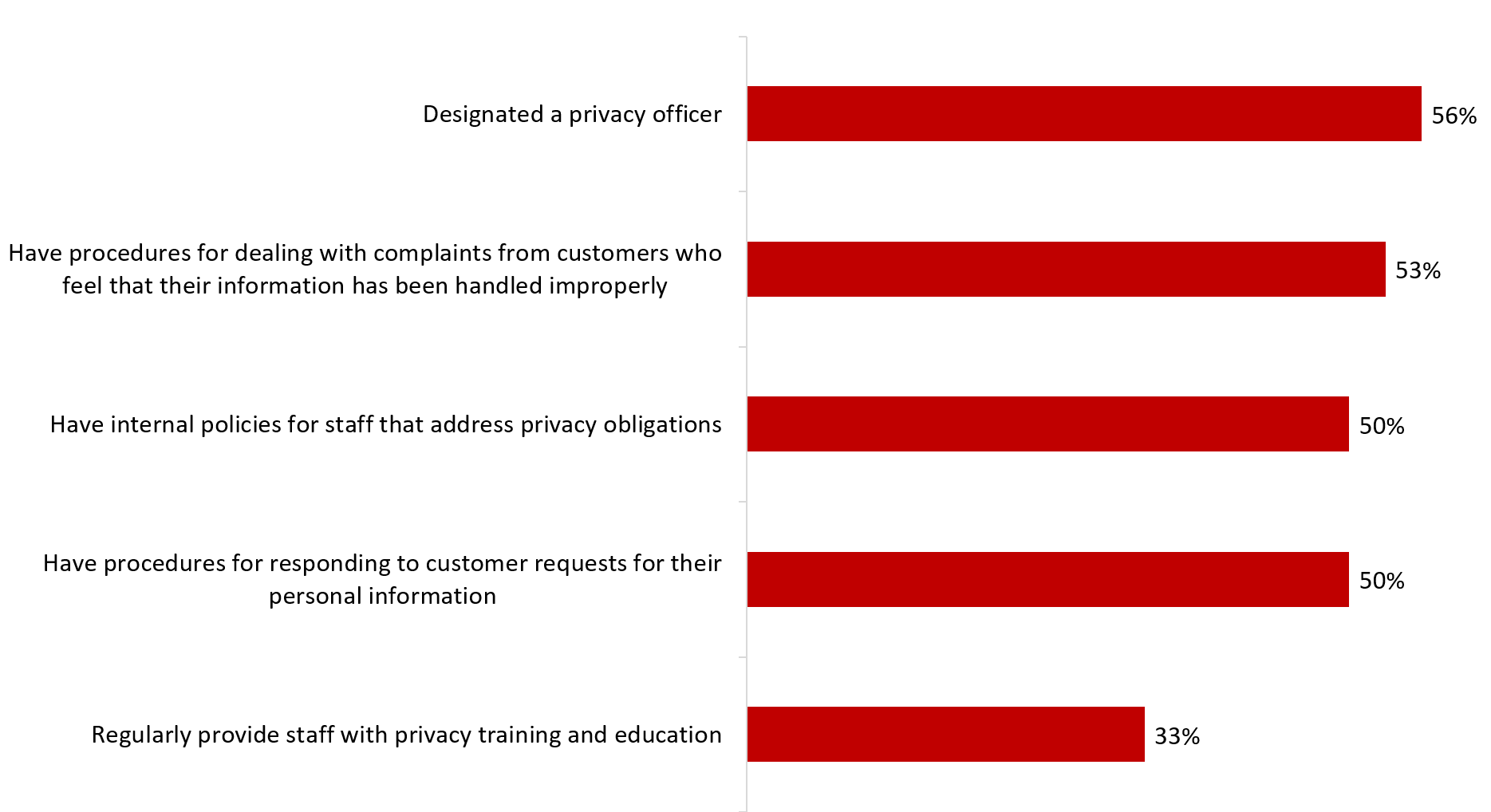
Q23 to Q27. Base: n=800; all respondents. Don’t know: 3% to 4%.
Text version of Figure 21
Figure 21: Actions taken to manage company privacy obligations
| % of respondents | |
|---|---|
| Designated a privacy officer | 56% |
| Have procedures for dealing with complaints from customers who feel that their information has been handled improperly | 53% |
| Have internal policies for staff that address privacy obligations | 50% |
| Have procedures for responding to customer requests for their personal information | 50% |
| Regularly provide staff with privacy training and education | 33% |
Implementation of these privacy practices is virtually unchanged since 2022, when a decline was reported across all measures. At the time, the decrease in the proportion of companies reporting having implemented these practices was considered within the context of the COVID-19 global pandemic, with some speculation that the pandemic may have affected the survey findings. This year’s findings suggest the decline in implementation between 2019 and 2022 may be a trend, rather than an isolated event influence by the pandemic.
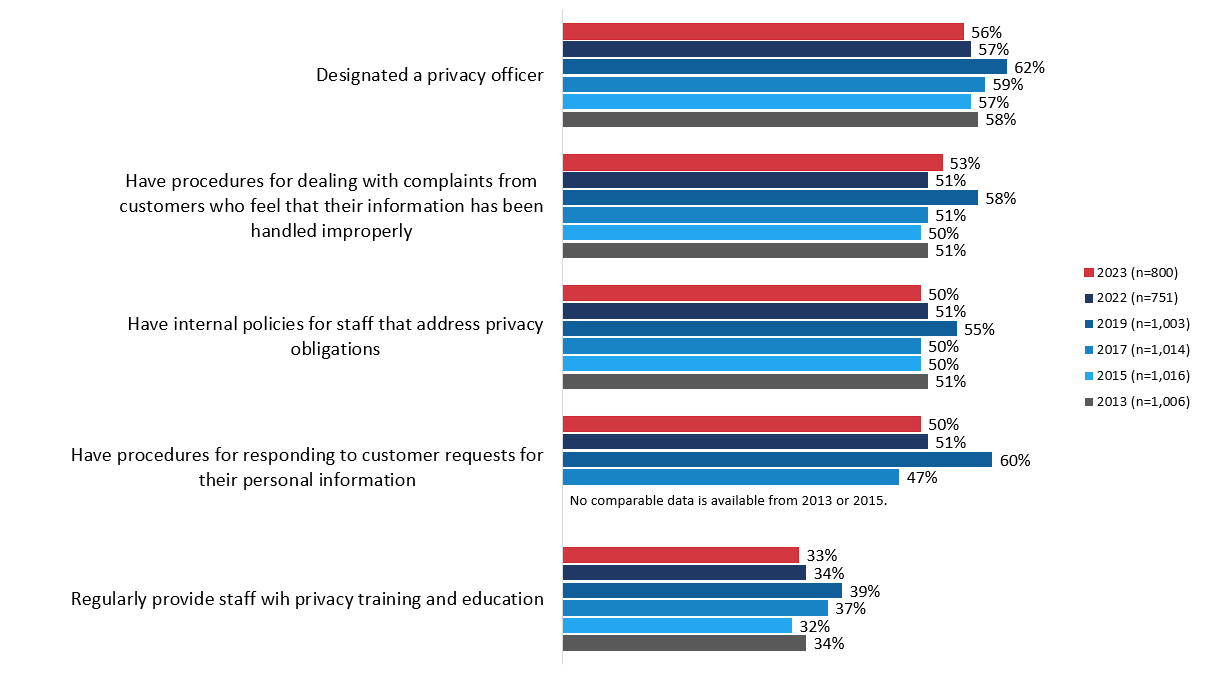
Text version of Figure 22
Figure 22: Actions taken to manage company privacy obligations [2013-present]
| 2023 (n=800) | 2022 (n=751) | 2019 (n=1,003) | 2017 (n=1,014) | 2015 (n=1,016) | 2013 (n=1,006) | |
|---|---|---|---|---|---|---|
| Designated a privacy officer | 56% | 57% | 62% | 59% | 57% | 58% |
| Have procedures for dealing with complaints from customers who feel that their information has been handled improperly | 53% | 51% | 58% | 51% | 50% | 51% |
| Have internal policies for staff that address privacy obligations | 50% | 51% | 55% | 50% | 50% | 51% |
| Have procedures for responding to customer requests for their personal information | 50% | 51% | 60% | 47% | No comparable data is available from 2013 or 2015. | |
| Regularly provide staff wih privacy training and education | 33% | 34% | 39% | 37% | 32% | 34% |
Uneven implementation of actions to safeguard the personal information
When it comes to safeguarding the personal information of customers and employees, approximately eight in 10 business representatives said their company requires passwords to access accounts (83%) and controls employee access to electronic files (79%). Roughly half reported that their company uses multi-factor authentication (53%) and encrypts stored data (49%) to safeguard customer and employee information. Following this, exactly one-third (33%) encrypt communications. Very few (4%) companies use voice prints authentication.
Regional differences were limited to two actions: multi-factor authentication and communications encryption. For both, companies based in Quebec were less likely than those based elsewhere in the country to have implemented each of these security measures. Specifically, 39% of companies in Quebec reportedly use multi-factor authentication compared to 58% each of companies in Ontario and western Canada, and 20% encrypt communications compared to 48% of companies in Ontario.
In addition, differences based on business size were evident for several of these measures, with small companies less likely than larger companies to require passwords (81%), to use multi-factor authentication (52%), and to control employee access to electronic files (77%).
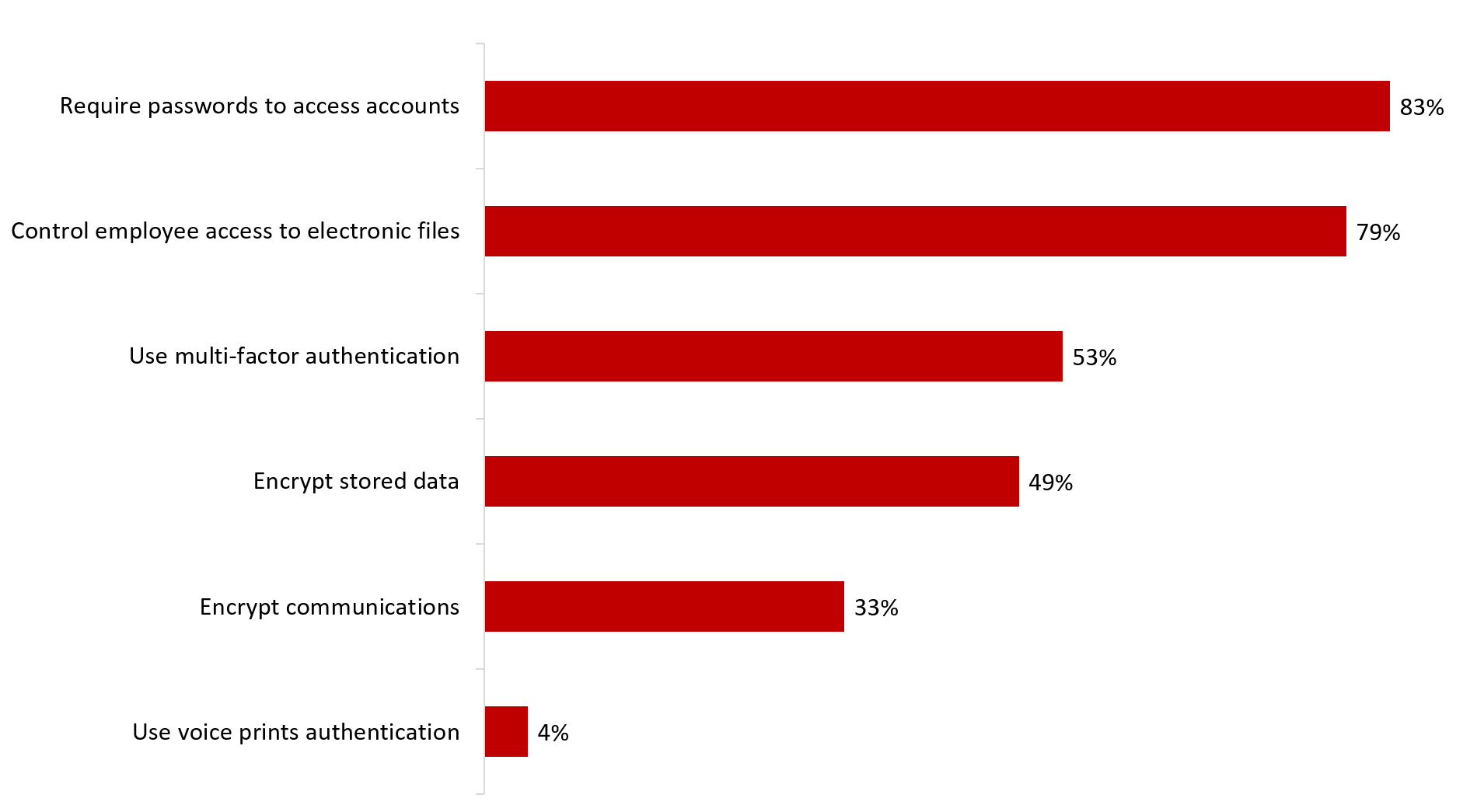
Q28A–F. Does your company take any of the following actions to safeguard personal information? Base: n=800; all respondents. Don’t know: 0% to 7%. Does not apply 4% to 6%.
Text version of Figure 23
Figure 23: Actions taken to safeguard personal data
| % of respondents | |
|---|---|
| Require passwords to access accounts | 83% |
| Control employee access to electronic files | 79% |
| Use multi-factor authentication | 53% |
| Encrypt stored data | 49% |
| Encrypt communications | 33% |
| Use voice prints authentication | 4% |
1 in 10 companies collect personal information from minors
Approximately one in 10 (12%) business representatives said their company collects personal information from customers who are under the age of 18. Most companies (88%) do not collection this information from minors.
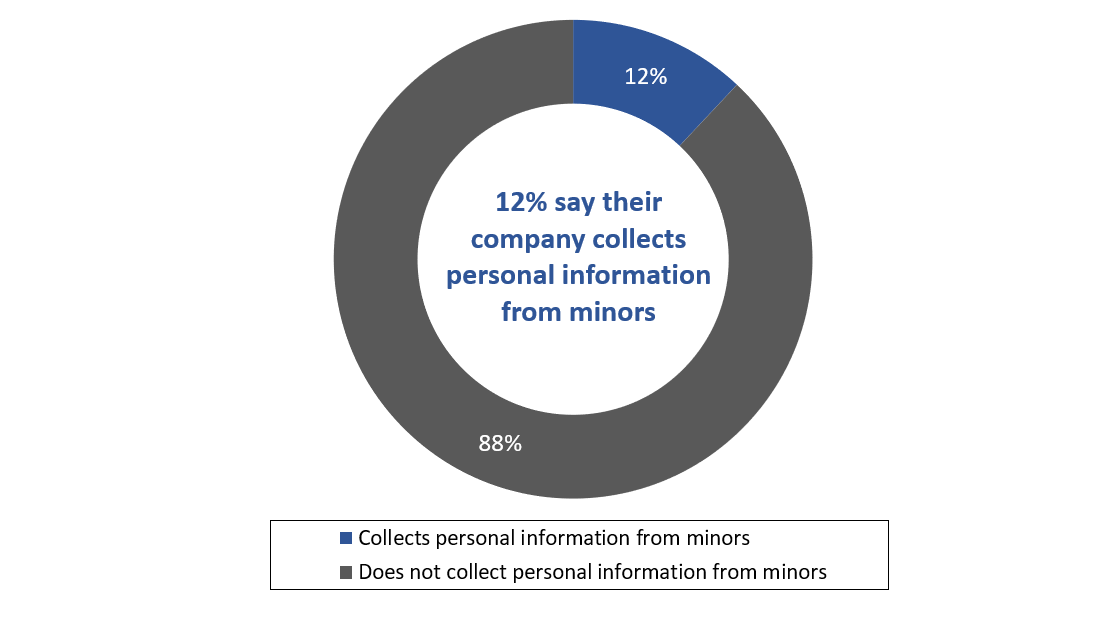
Q29. Does your company collect personal information from customers who are minors, that is under the age of 18? Base: n=800; all respondents. Don’t know: <1%.
Text version of Figure 24
Figure 24: Collecting personal information from minors
| % of respondents | |
|---|---|
| Collects personal information from minors | 12% |
| Does not collect personal information from minors | 88% |
12% say their company collects personal information from minors
Companies in Atlantic Canada (24%) were more likely to collect personal information from minors compared to companies based elsewhere in the country (10% of companies in Ontario and 9% in western Canada). Similarly, companies that sell only to consumers (23%) were much more likely than those that sell to business and consumers (12%) to collect personal information from minors. Large companies (20% versus 11% of small companies) and companies that have taken steps to comply with their privacy obligations (14% versus 3% of those that have not) also were more likely to collect information from minors.
Additionally, companies operating in the following industries or sectors of the economyFootnote 7 tended to be more likely to collect personal information from minors: education services, social services, and finance and insurance.
Companies implement various practices when collecting personal information from minors
A majority of business representatives who said their company collects personal information from minors (n=67) verify age (82%), explain privacy policies and practices in simple, age-appropriate language (73%), and obtain parental consent (69%) when collecting information from those under the age of 18. Smaller, and similar proportions make it easy for young people to delete their account or the information they have posted (30%), employ strong privacy settings by default, for example, automatically turning off location tracking (29%), and conduct privacy impact assessments before launching products or tools aimed at young people (27%).
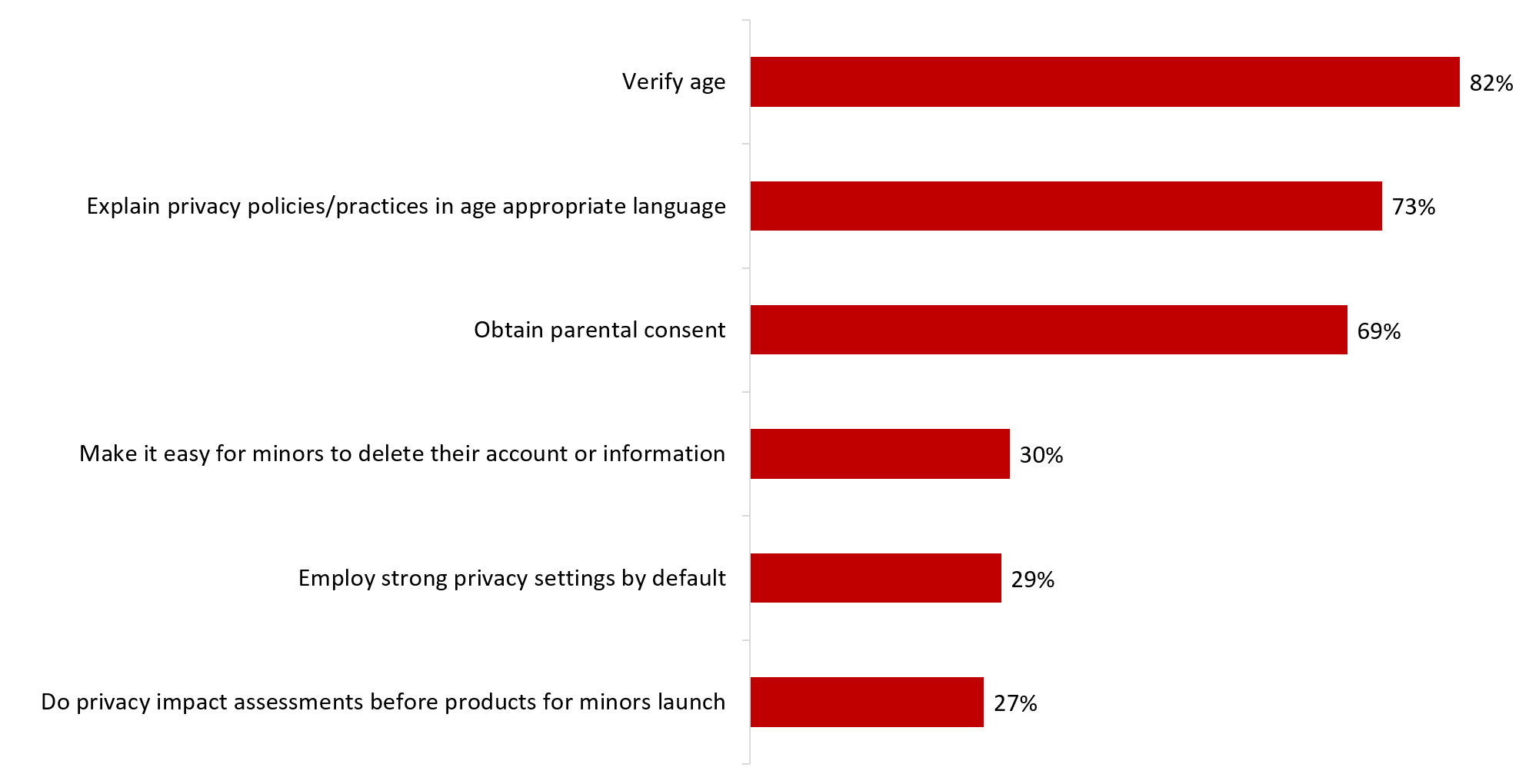
Q30A-F. When collecting information from minors, does your company do any of the following? Base: n=67; those who collect information from minors. Don’t know: 0% to 8%. Does not apply: 5% to 46%.
Text version of Figure 25
Figure 25: Actions taken when collecting personal information from minors
| % of respondents | |
|---|---|
| Verify age | 82% |
| Explain privacy policies/practices in age appropriate language | 73% |
| Obtain parental consent | 69% |
| Make it easy for minors to delete their account or information | 30% |
| Employ strong privacy settings by default | 29% |
| Do privacy impact assessments before products for minors launch | 27% |
5. Privacy policies
This section focuses on the content of company’s privacy policies.
Majority of surveyed companies have a privacy policy
Just over half (55%) of the business representatives surveyed said their company has a privacy policy. Over time, the proportion of companies with a privacy policy has declined, from a high of 65% in 2019, to 59% in 2022, to 55% this year. In 2022, the decrease in the proportion of companies reporting a privacy policy was considered within the context of the COVID-19 global pandemic. Specifically, when businesses were preoccupied with the impact of the pandemic on operations, it was reasonable to assume that privacy responsibilities might not be top-of-mind. This year’s findings suggest the decline in privacy policies may be a trend, rather than an isolated event influence by the pandemic.
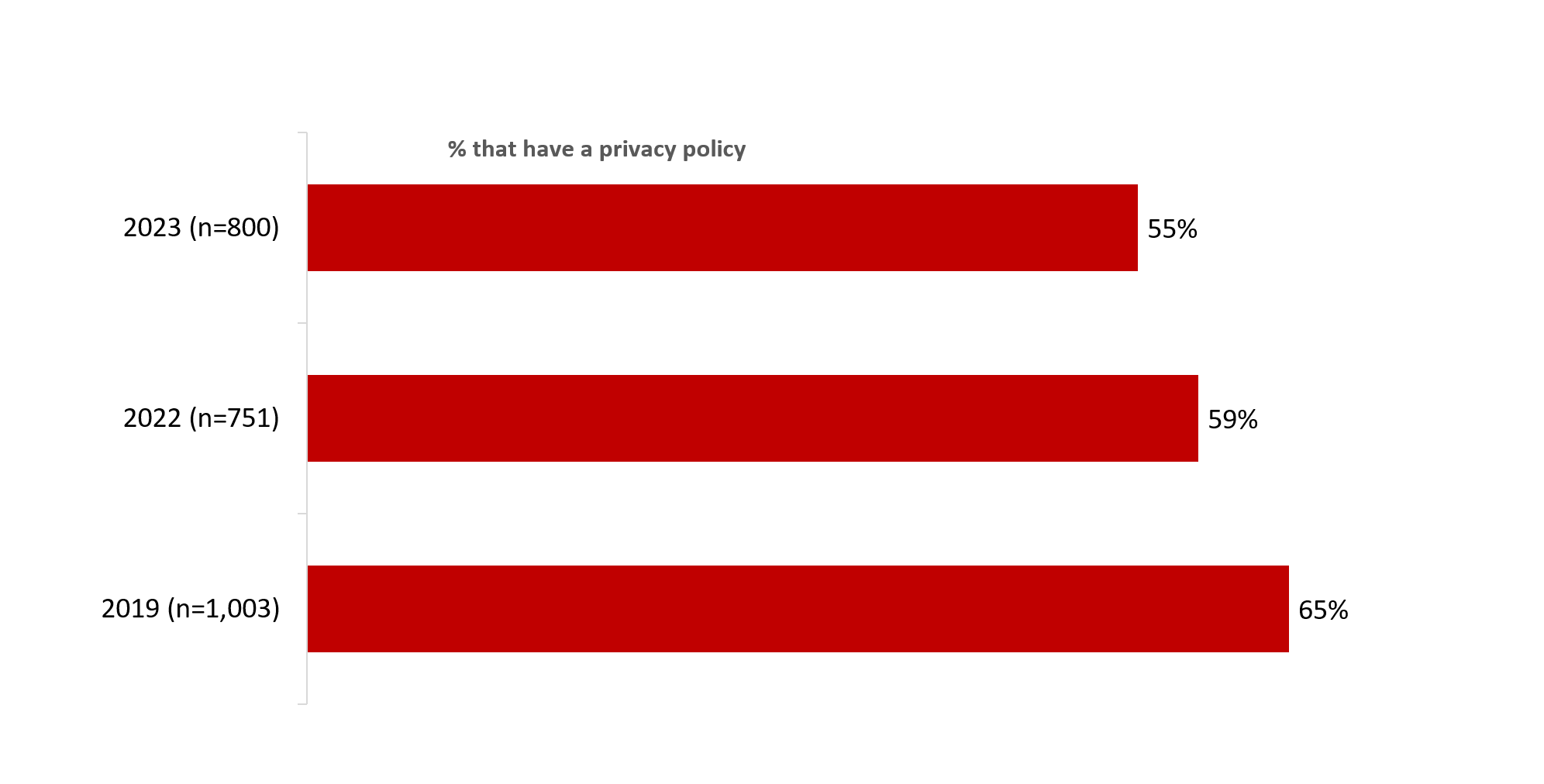
Q31. Does your company have a privacy policy? Base: all respondents.
Text version of Figure 26
Figure 26: Use of privacy policies [2019-present]
| % that have a privacy policy | |
|---|---|
| 2019 (n=1,003) | 65% |
| 2022 (n=751) | 59% |
| 2023 (n=800) | 55% |
Companies in Quebec (36%) were less likely than those in Atlantic Canada (65%), Ontario (62%), and western Canada (57%) to have a privacy policy. Additionally, as business size increased so did the likelihood of having a privacy policy. Half (53%) of small businesses have a privacy policy compared to two-thirds (67%) of medium-sized businesses, and nearly nine in 10 (87%) large businesses. Companies that use AI (78%) were more likely than those that do not (54%) to have a privacy policy, as were companies that collect information from minors (82% versus 52% of those that do not), and companies aware that the OPC has resources available to companies to help them comply with their privacy obligations (68% versus 46% of those unaware).
Companies’ privacy policies had varying levels of plain language disclosures
Among companies that have a privacy policy (n=472), most explain in plain language the following: the purpose for which the company collects, uses, and discloses customers’ personal information (85%); what personal information is being collected (81%); and how the company collects, uses, and discloses this information (80%). In addition, seven in 10 (70%) explain in plain language with which parties the personal information collected will be shared, two-thirds (67%) for how long the company keeps the personal information, and six in 10 (62%) how the company disposes of customers’ personal information. Just over half (55%) said their company’s policy explains in plain language the risks of harm in the event of a data breach.

Q32A-G. Does your privacy policy explain in plain language…? Base: n=472; companies with privacy policies. Don’t know: 3% to 9%; Does not apply: 3% to 6%.
Text version of Figure 27
Figure 27: Privacy policy disclosures
Does your privacy policy explain in plain language…:
| 2023 (n=472) | |
|---|---|
| For what purposes it is being collected, used or disclosed? | 85% |
| What personal information is being collected? | 81% |
| How personal information is collected, used, or disclosed? | 80% |
| With which parties it will be shared? | 70% |
| For how long your company keeps customers’ personal information? | 67% |
| How your company disposes of customers’ personal information? | 62% |
| Risk of harm in event of a breach? | 55% |
Companies in Quebec were more likely than those based in Ontario or western Canada to include in their privacy policy plain language about how long the company keep customers’ personal information (87% versus 63% and 64%, respectively) and about how the company disposes of personal information (85% versus 55% and 60%, respectively).
When looking at whether companies have plain language disclosures in their privacy policies, the 2023 results are generally consistent with previous years. The one noteworthy change over time has been the proportion of companies that disclose, in plain language, for how long customers’ personal information is kept. This increased from 57% in 2022 to 67% in 2023. All other year-over-year changes did not exceed 4%.
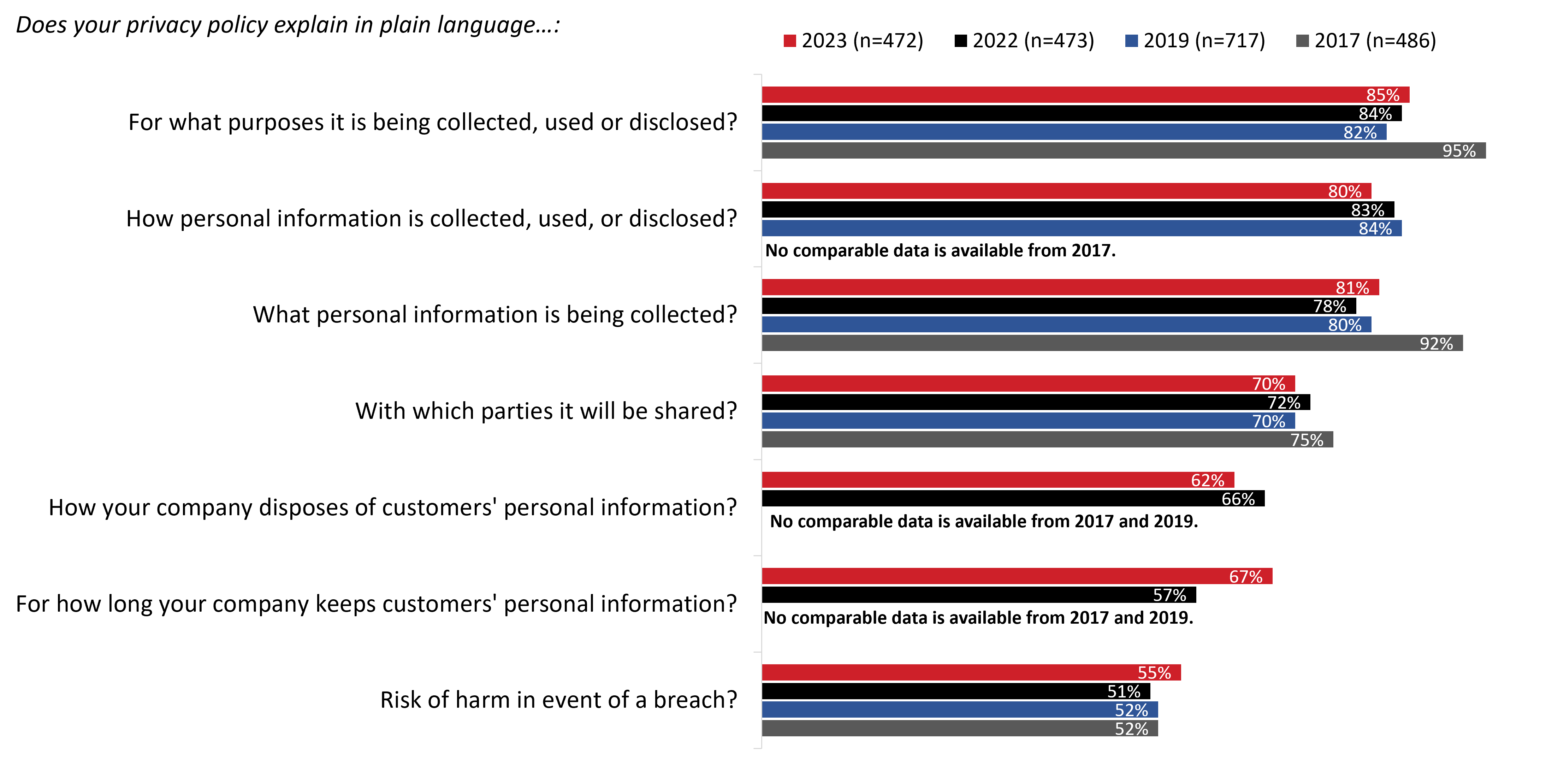
Q32. Does your privacy policy explain in plain language…? Base: n=472; companies with privacy policies.
Text version of Figure 28
Figure 28: Privacy policy disclosures [2017-present]
Does your privacy policy explain in plain language…:
| 2023 (n=472) | 2022 (n=473) | 2019 (n=717) | 2017 (n=486) | |
|---|---|---|---|---|
| For what purposes it is being collected, used or disclosed? | 85% | 84% | 82% | 95% |
| How personal information is collected, used, or disclosed? | 80% | 83% | 84% | No comparable data is available from 2017. |
| What personal information is being collected? | 81% | 78% | 80% | 92% |
| With which parties it will be shared? | 70% | 72% | 70% | 75% |
| How your company disposes of customers’ personal information? | 62% | 66% | No comparable data is available from 2017 and 2019. | |
| For how long your company keeps customers’ personal information? | 67% | 57% | No comparable data is available from 2017 and 2019. | |
| Risk of harm in event of a breach? | 55% | 51% | 52% | 52% |
Proactive communications of privacy practices varies
Business representatives who said their company has a privacy policy (n=472) were asked whether their company communicates with customers about different aspects of its privacy practices. Exactly two-thirds (67%) said their company explains how customers can raise a privacy concern or ask a privacy question. Following this, approximately six in 10 companies make clear whether the collection, use or disclosure of information is a condition of service (62%), make privacy information easily accessible to customers (60%), and explain how customers can request access to their personal information (59%).
Just under half explain how customers can file a formal privacy complaint (49%), actively promote their company’s privacy practices (49%), and notify customers when making changes to their privacy policy (47%). Four in 10 (41%) business representatives said their company obtains consent from customers when making changes to their privacy practices.
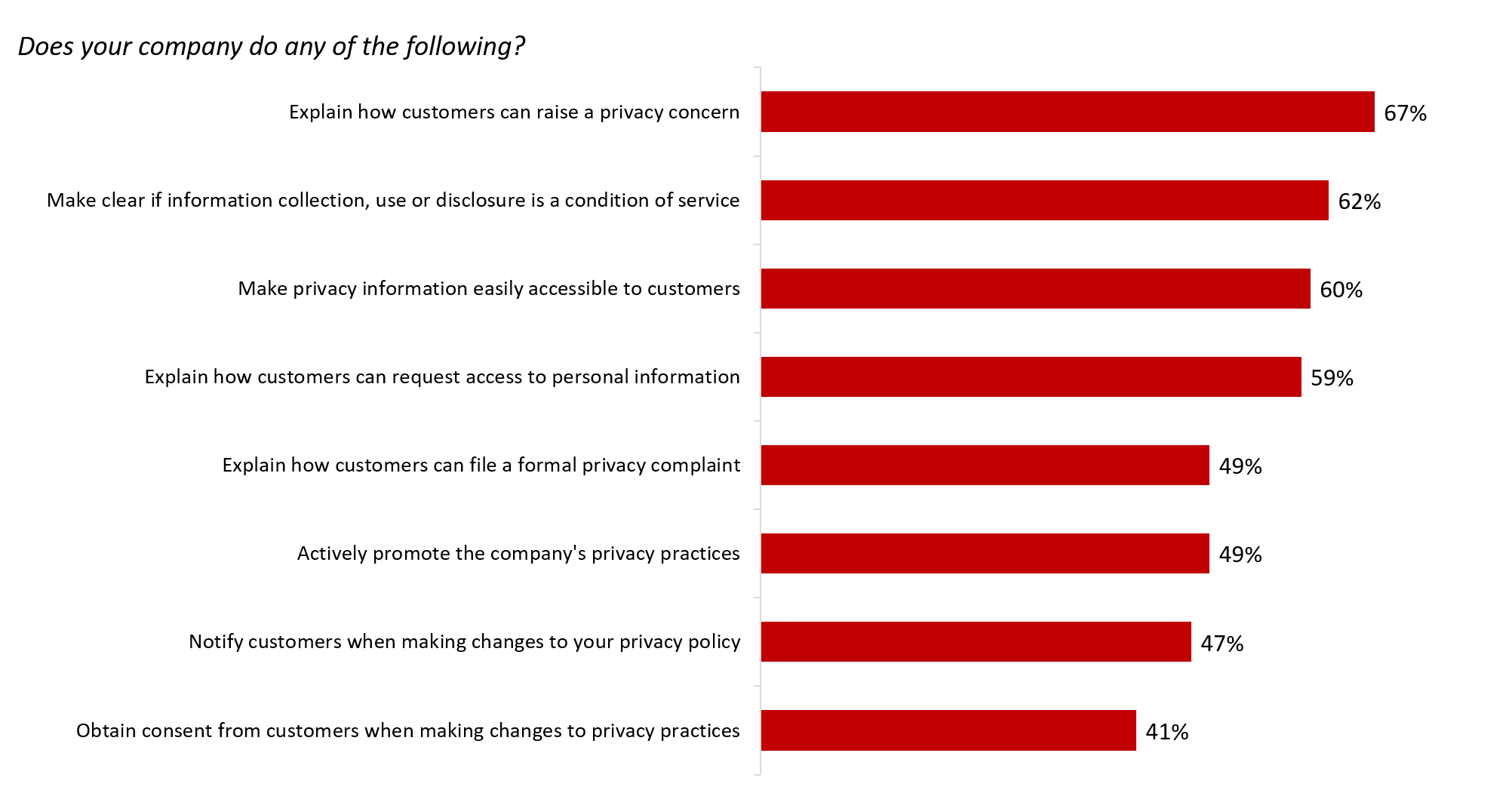
Q33A–H. Does your company do any of the following? Base: n=472; companies with privacy policies. Don’t know: 2% to 6%; Does not apply: 1% to 6%.
Text version of Figure 29
Figure 29: Communication of company privacy practices
Does your company do any of the following?
| % of respondents | |
|---|---|
| Explain how customers can raise a privacy concern | 67% |
| Make clear if information collection, use or disclosure is a condition of service | 62% |
| Make privacy information easily accessible to customers | 60% |
| Explain how customers can request access to personal information | 59% |
| Explain how customers can file a formal privacy complaint | 49% |
| Actively promote the company’s privacy practices | 49% |
| Notify customers when making changes to your privacy policy | 47% |
| Obtain consent from customers when making changes to privacy practices | 41% |
There were several noteworthy regional differences, and to the extent that a pattern emerged, differences often separated Quebec from the rest of the country. Companies in Atlantic Canada (67%) and Quebec (62%) were more likely than those in Ontario (33%) and western Canada (38%) to obtain consent from customers before making changes to their privacy practices. Companies in Quebec (77%) were more likely than those in western Canada (54%) to make privacy information accessible, and compared to those in Ontario (52%), companies in Quebec (74%) were also more likely to explain how customers can request access to their personal information. In addition, companies in Quebec (85%) were the most likely to explain how customers can file a formal privacy complaint (versus 42% of companies in Atlantic Canada, 41% in Ontario and 47% in western Canada).
Over time transparency vis-à-vis company privacy practices has fluctuated, with the most significant year-over-year changes a decline in the proportion of companies that explain how customers can file a formal privacy complaint (from 60% in 2022 to 49% in 2023), that make privacy information easily accessible (from 70% in 2022 to 60% in 2023), and that explain how customers can request access to personal information (from 69% in 2022 to 59% this year). Other year-over-year changes did not exceed 4%.
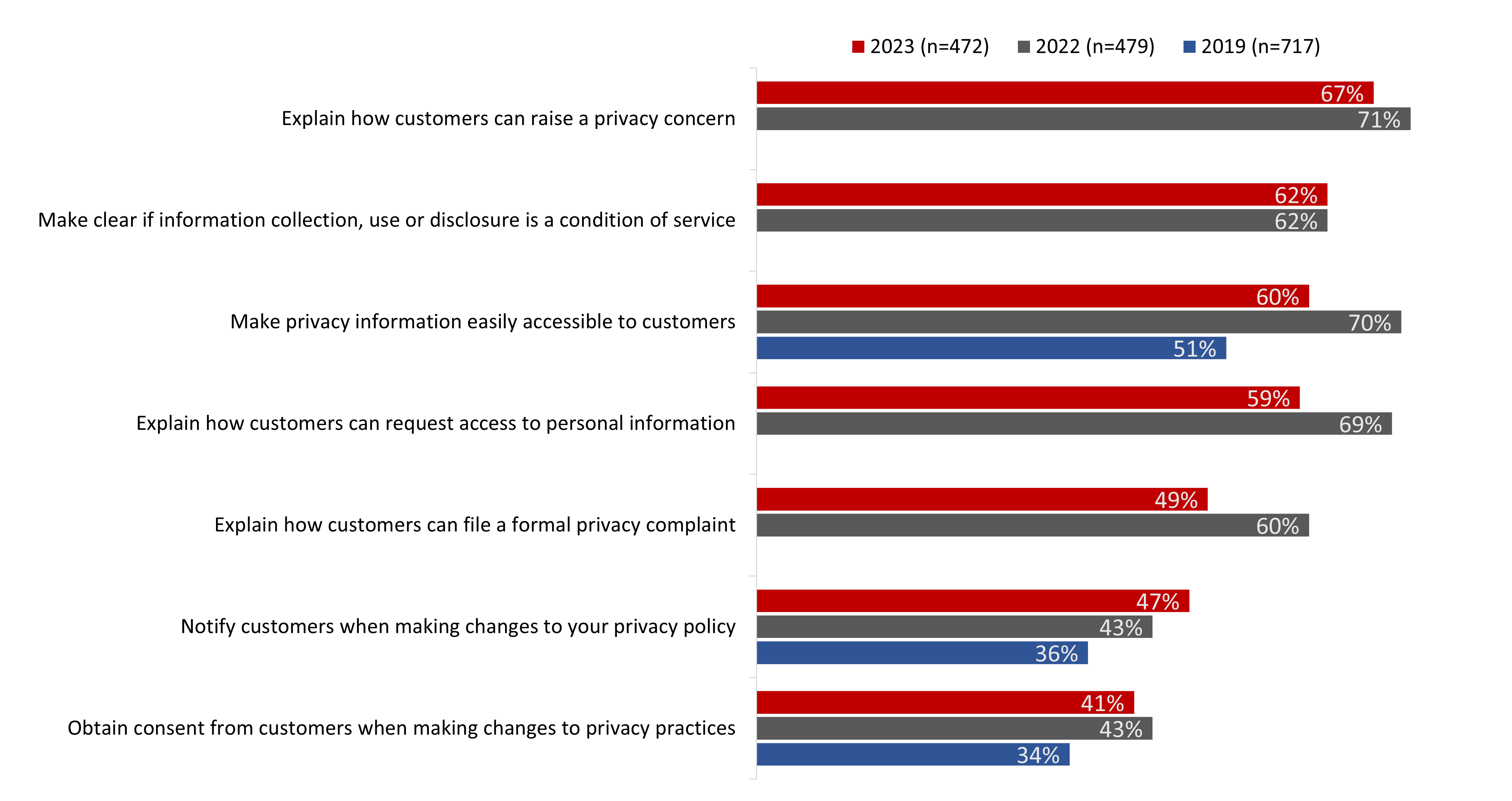
Q33A–H. Does your company do any of the following? Base: companies with privacy policies.
Text version of Figure 30
Figure 30: Communication of company privacy practices [2019-present]
Does your company do any of the following?
| 2023 (n=472) | 2022 (n=479) | 2019 (n=717) | |
|---|---|---|---|
| Explain how customers can raise a privacy concern | 67% | 71% | No comparable data is available from 2019. |
| Make clear if information collection, use or disclosure is a condition of service | 62% | 62% | No comparable data is available from 2019. |
| Make privacy information easily accessible to customers | 60% | 70% | 51% |
| Explain how customers can request access to personal information | 59% | 69% | No comparable data is available from 2019. |
| Explain how customers can file a formal privacy complaint | 49% | 60% | No comparable data is available from 2019. |
| Notify customers when making changes to your privacy policy | 47% | 43% | 36% |
| Obtain consent from customers when making changes to privacy practices | 41% | 43% | 34% |
6. Managing privacy risks
This section examines how Canadian business manage privacy risks, include data breaches.
More than one-third of companies have policies or procedures to assess privacy risks
More than one-third (37%) of business representatives said their company has policies or procedures in place to assess privacy risks related to their business, including assessing privacy risks associated with the development or use of new products, services, or technologies. Thirty-seven percent represents an increase since 2022, when the proportion of companies reporting use of risk management policies declined to 33% (from 38% in 2019).
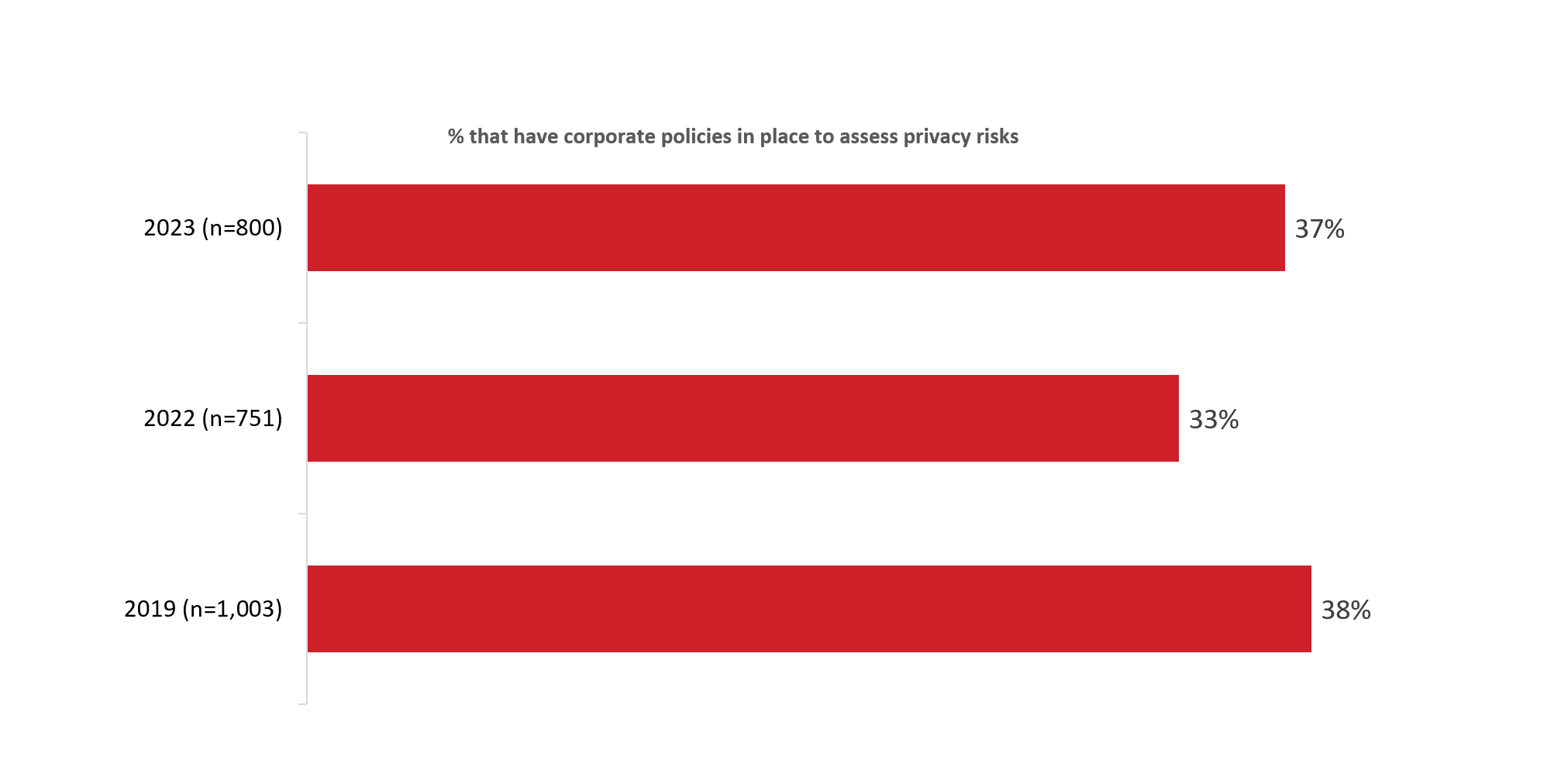
Q34. Does your company have any policies or procedures in place to assess privacy risks related to your business? Base: all respondents.
Text version of Figure 31
Figure 31: Corporate policies and procedures to assess privacy risks [2019-present]
| Company has policies to assess privacy risks | |
|---|---|
| 2019 (n=1,003) | 38% |
| 2022 (n=751) | 33% |
| 2023 (n=800) | 37% |
% that have corporate policies in place to assess privacy risks
Companies that sell only to consumers (47%) were more likely to have privacy risk policies and procedures in place compared to companies that sell only to businesses (32%) and to consumers and businesses (34%). In addition, as business size increased so too did the likelihood of having such policies and procedures in place, from 35% of small businesses, to 45% of medium-sized businesses, to 59% of large businesses. Companies that collect personal information from minors (56%) were more likely than companies that do not (34%) to have risk assessment policies or procedures in place.
Half have a least some concern about a data breach
Business representatives were asked to rate their level of concern about a data breach, where the personal information of their customers is compromised. Before being asked this question, interviewers provided the following information:
Data breaches can be caused by criminal activity, theft, hacking, or employee error such as misplacing a laptop or portable device.
Respondents were split with regards to their level of concern about a data breach involving customers’ personal information. Just over half (52%) of surveyed business representatives said they are least somewhat concerned (scores of 3 to 7 on a 7-point scale), including one-quarter (26%) who are highly concerned (score of 6 and 7). Conversely, almost as many (47%) reported a low level of concern (scores of 1 and 2), including nearly one-third (32%) who are not all concerned about a data breach.
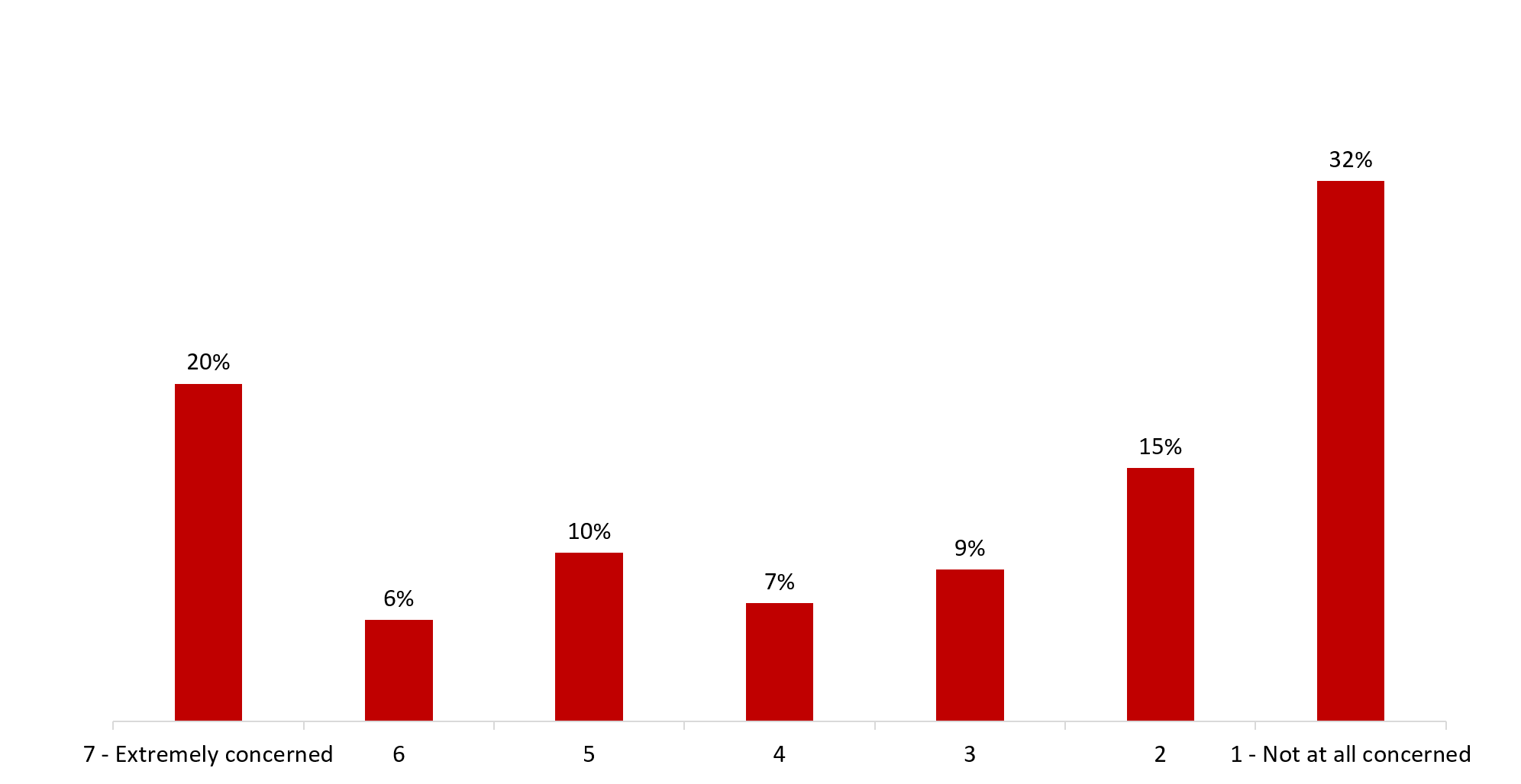
Q35. How concerned are you about a data breach, where the personal information of your customers is compromised? Base: n=800; all respondents. Don’t know: 1%.
Text version of Figure 32
Figure 32: Level of concern about a data breach
| % of respondents | |
|---|---|
| 7 - Extremely concerned | 20% |
| 6 | 6% |
| 5 | 10% |
| 4 | 7% |
| 3 | 9% |
| 2 | 15% |
| 1 - Not at all concerned | 32% |
Business representatives in Quebec were the most likely to be highly concerned about a data breach: 42% compared to 23% of those who reside in Atlantic Canada and Ontario, and 20% of those in western Canada.
The proportion of business representative highly concerned about a data breach continues to decline since the high of 37% recorded in 2019.
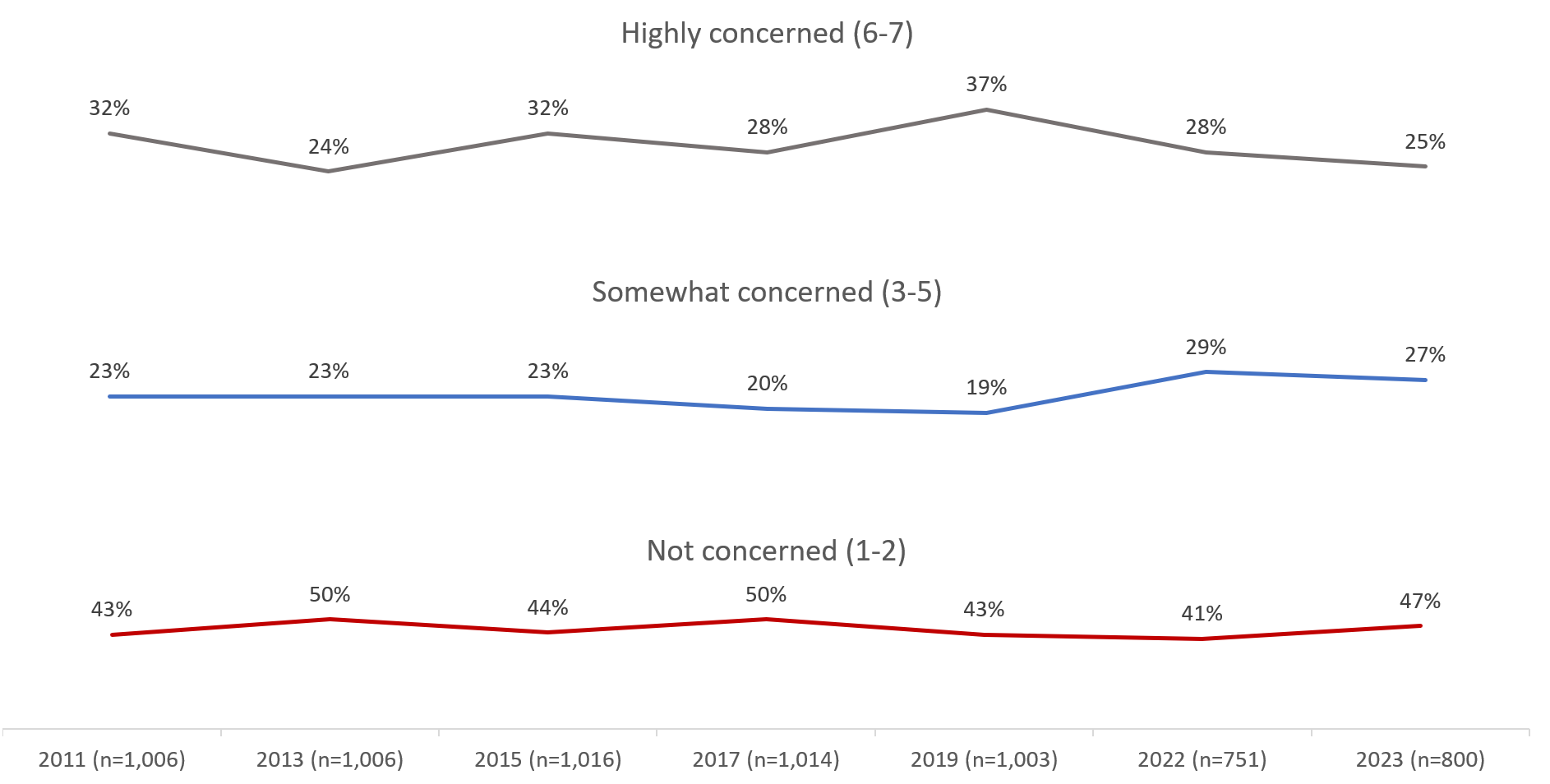
Net calculations are based on unrounded percentages.
Q35. How concerned are you about a data breach, where the personal information of your customers is compromised?
Text version of Figure 33
Figure 33: Level of concern about a data breach [2011-present]
| Highly concerned (6-7) | |
|---|---|
| 2011 (n=1,006) | 32% |
| 2013 (n=1,006) | 24% |
| 2015 (n=1,016) | 32% |
| 2017 (n=1,014) | 28% |
| 2019 (n=1,003) | 37% |
| 2022 (n=751) | 28% |
| 2023 (n=800) | 25% |
| Somewhat concerned (3-5) | |
|---|---|
| 2011 (n=1,006) | 23% |
| 2013 (n=1,006) | 23% |
| 2015 (n=1,016) | 23% |
| 2017 (n=1,014) | 20% |
| 2019 (n=1,003) | 19% |
| 2022 (n=751) | 29% |
| 2023 (n=800) | 27% |
| Not concerned (1-2) | |
|---|---|
| 2011 (n=1,006) | 43% |
| 2013 (n=1,006) | 50% |
| 2015 (n=1,016) | 44% |
| 2017 (n=1,014) | 50% |
| 2019 (n=1,003) | 43% |
| 2022 (n=751) | 41% |
| 2023 (n=800) | 47% |
Most companies are at least somewhat prepared to deal with a data breach
More than eight in 10 (84%) survey respondents said their company is at least somewhat prepared to respond to a data breach involving personal information (scores of 3 to 7 on a 7-point scale), including close to half (46%) who said their company is highly prepared (scores of 6 and 7) for such an event. Fourteen percent felt their company is not prepared for a data breach (scores of 1 and 2).
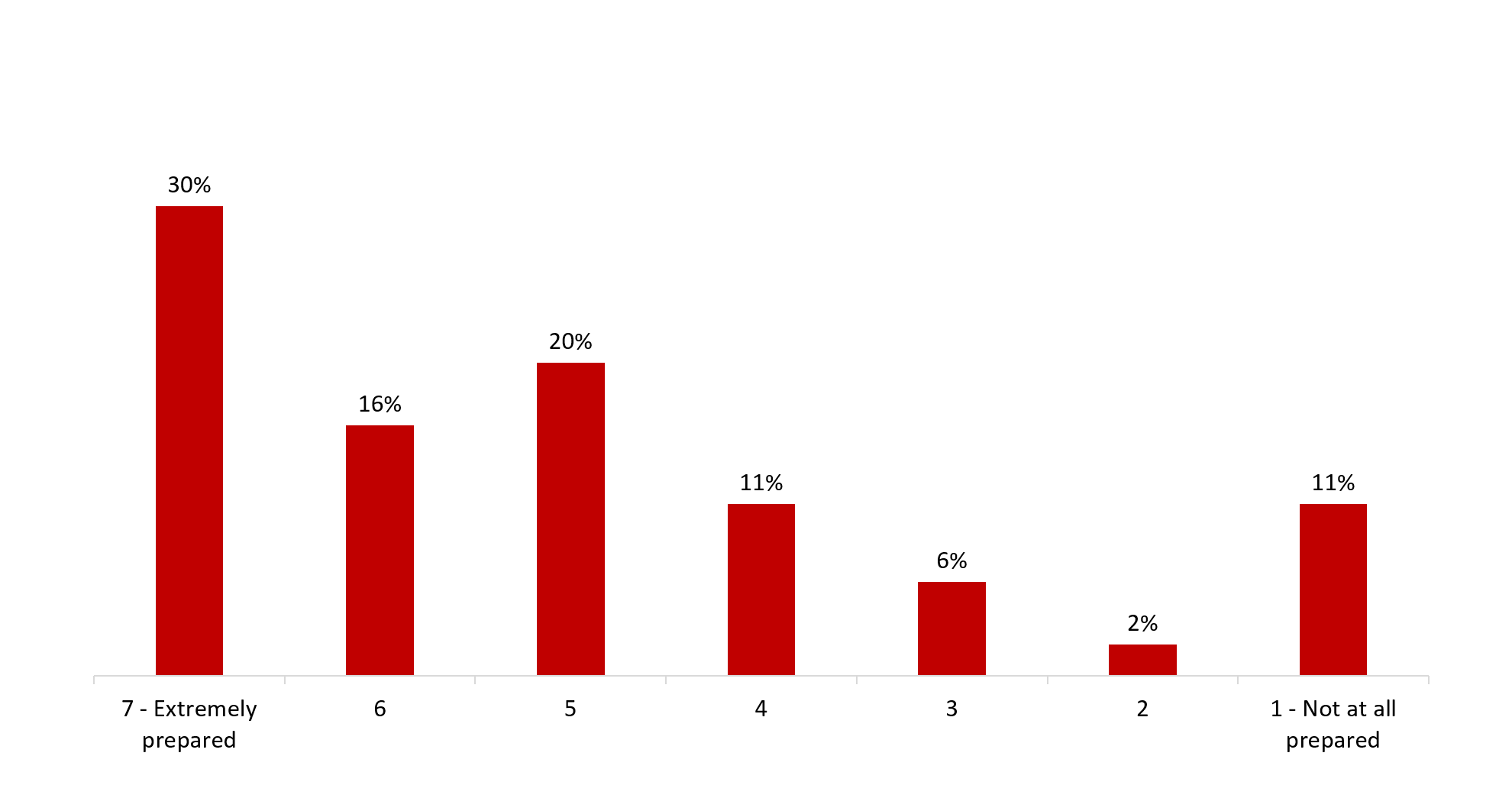
Q36. To what extent is your company prepared to respond to a data breach involving personal information? Base: n=800; all respondents. Don’t know: 3%
Text version of Figure 34
Figure 34: Preparedness to deal with data breaches
| % of respondents | |
|---|---|
| 7 - Extremely prepared | 30% |
| 6 | 16% |
| 5 | 20% |
| 4 | 11% |
| 3 | 6% |
| 2 | 2% |
| 1 - Not at all prepared | 11% |
As company size increased so too did preparedness. Seven in 10 (71%) large businesses would be highly prepared (scores of 6 and 7) to respond to a data breach compared to 48% of medium-sized businesses and 45% of small businesses. In addition, companies using AI (71% versus 44% of those not using AI), those that have taken steps to comply with privacy laws (51% versus 24% that have not), and those aware of the OPC’s resources for businesses (55% versus 38% unaware) were more likely to be highly prepared to respond.
Vast majority of companies have not experienced a privacy breach
The vast majority of business representatives (93%) said their company has never experienced a breach where the personal information of their customers was compromised. The incidence of reported privacy breaches has been consistent for the last decade (4% in 2013, 2019 and 2022 and 6% in 2023).
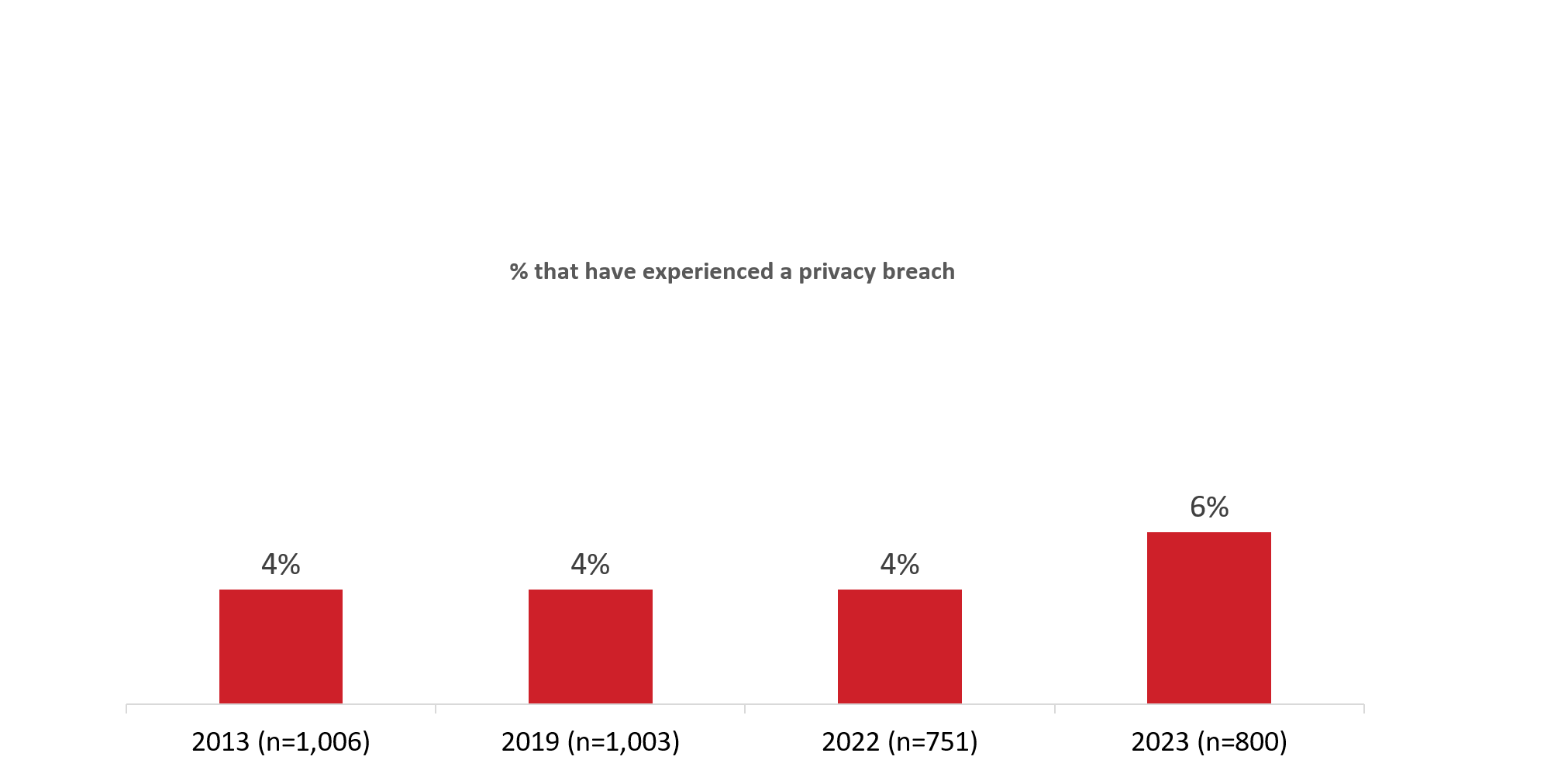
Q37. Has your company ever experienced a breach where the personal information of your customers was compromised? Base: all respondents.
Text version of Figure 35
Figure 35: Data breaches [2013-present]
| Company has policies to assess privacy risks | |
|---|---|
| 2013 (n=1,006) | 4% |
| 2019 (n=1,003) | 4% |
| 2022 (n=751) | 4% |
| 2023 (n=800) | 6% |
% that have experienced a privacy breach
Almost all companies that have experienced a data breach keep records of what was lost
Almost all (94%) companies that have experienced a data breach (n=46)Footnote 8 keep records of all data breaches involving customers’ personal information.
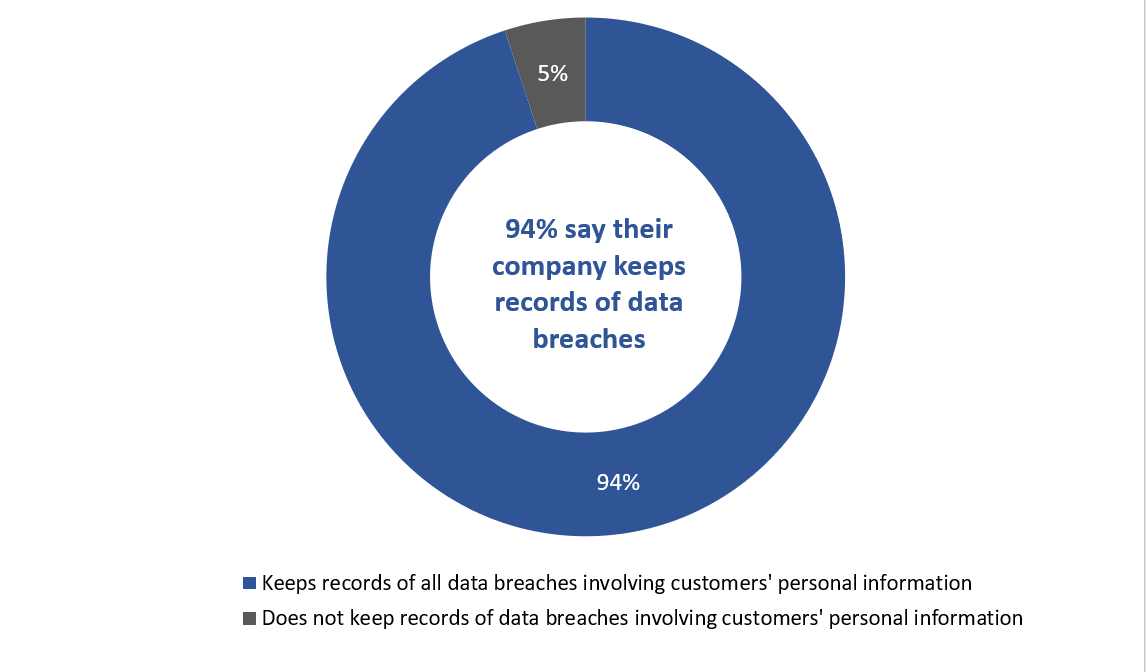
Q38. Does your company ensure that it keeps records of all data breaches involving your customers’ personal information? Base: n=46, those who have experienced a data breach. Don’t know: <1%.
Text version of Figure 36
Figure 36: Record keeping for data breaches
| % of respondents | |
|---|---|
| Keeps records of all data breaches involving customers’ personal information | 94% |
| Does not keep records of data breaches involving customers’ personal information | 5% |
94% say their company keeps records of data breaches
Appendix
Corporate profile of responding companies
The following tables present the characteristics of Canadian businesses included in the survey sample (using weighted data), as well as business representatives.
| Customer type | Percent |
|---|---|
| Sells directly to consumers | 27% |
| Sells directly to businesses | 29% |
| Sells directly to consumers and businesses | 44% |
| Region | Percent |
|---|---|
| Atlantic Canada | 7% |
| Quebec | 19% |
| Ontario | 38% |
| Prairies | 7% |
| Alberta | 15% |
| British Columbia | 14% |
| Number of employees | Percent |
|---|---|
| 1 employee (self-employed) | 14% |
| 2-4 employees | 23% |
| 5-9 employees | 24% |
| 10-19 employees | 28% |
| 20-99 employees | 11% |
| 100+ employees | 1% |
| Industry/sector | Percent |
|---|---|
| Construction | 12% |
| Professional, Scientific and Technical Services | 12% |
| Retail Trade | 11% |
| Other Services (except Public Administration) | 9% |
| Accommodation and Food Services | 7% |
| Health Care and Social Assistance | 6% |
| Agriculture, Forestry, Fishing and Hunting | 5% |
| Wholesale Trade | 5% |
| Transportation and Warehousing | 5% |
| Finance and Insurance | 5% |
| Information and Cultural Industries | 4% |
| Manufacturing | 4% |
| Educational Services | 4% |
| Arts, Entertainment and Recreation | 2% |
| Industry/sector (cont’d.) | Percent |
|---|---|
| Administrative and Support, Waste Management and Remediation Services | 2% |
| Real Estate and Rental and Leasing | 2% |
| Other | 4% |
| Respondent position | Percent |
|---|---|
| Owner, President, or CEO | 44% |
| General manager/other manager | 27% |
| Administration | 9% |
| Director | 4% |
| Accountant/bookkeeper | 4% |
| Another title | 11% |
Survey questionnaire
Introduction
1st POINT OF CONTACT/GATEKEEPER:
Hello/bonjour, my name is [Interviewer’s name]. Would you prefer to continue in English or French? / Préférez-vous continuer en anglais ou en français? May I speak to the person in your company who is the most familiar with the types of personal information collected about your customers, and how this information is stored and used. This may be your company’s Privacy Officer if you have one.
IF ASKED BY GATEKEEPER:
I’m calling on behalf of Phoenix SPI, a public opinion research company. We’re conducting a survey for the Privacy Commissioner of Canada to better understand the needs and practices of businesses across the country in relation to Canada’s privacy laws.
- IF PERSON IS AVAILABLE, CONTINUE. REPEAT INTRODUCTION IF NEEDED.
- IF NOT AVAILABLE, SCHEDULE CALL-BACK.
RESPONDENT:
Hello/Bonjour, my name is [Interviewer’s name]. I’m calling on behalf of Phoenix SPI, a public opinion research company. We’re conducting a survey for the Privacy Commissioner of Canada to better understand the needs and practices of businesses across the country in relation to Canada’s privacy laws.
The survey takes about 15 minutes and is voluntary. Your responses will be kept confidential and anonymous, and the information you provide will be administered according to the requirements of the Privacy Act, the Access to Information Act, and any other pertinent legislation.The survey is registered with the Canadian Research Insights Council’s survey validation system.
May I continue?
- Yes, now [CONTINUE]
- No, call later. Specify date/time: Date: Time:
- Refused [THANK/DISCONTINUE]
INTERVIEWER NOTE:
Screening and background information
- Which of the following best describes your company? [READ LIST, ACCEPT ONE RESPONSE]
- 01. It sells directly to individual consumers *
- 02. It sells directly to other businesses/organizations**
- 03. It sells directly both to consumers and other businesses/organizations
- 04. [DO NOT READ] Other, please specify: [THANK AND TERMINATE]
- 05. [DO NOT READ] Not for profit [THANK AND TERMINATE]
- 99. [DO NOT READ] Don’t know/refusal [THANK AND TERMINATE]
INTERVIEWER NOTES:
*IF ASKED ABOUT RESPONSE OPTION (1) “CONSUMERS”, SAY: This refers to an individual not a business or organization.
**IF ASKED ABOUT “ORGANIZATIONS”, SAY: This includes selling to governments.
- Approximately how many employees work for your company in Canada? Please include part-time employees as full-time equivalents. [DO NOT READ LIST]
- 01. One (i.e. self-employed)
- 02. 2-4
- 03. 5-9
- 04. 10-19
- 05. 20-49
- 06. 50-99
- 07. 100-149
- 08. 150-199
- 09. 200-249
- 10. 250-299
- 11. 300-499
- 12. 500-999
- 13. 1,000-4,999
- 14. More than 5,000
- 99. [DO NOT READ] Don’t know/refusal [THANK AND TERMINATE]
Section 1. Customers’ Personal Information
I’d like to begin by asking about the personal information your company collects about customers. By personal information, I mean things like a customer’s name, email address, opinions, purchase history, or financial information, such as their credit card, but it can also include biometric data, such as fingerprints or voice prints, photos or videos, as well as chat or instant message histories.
To start,
- What does your company do with the personal information that it collects about customers? Is it used ...? [READ LIST. ACCEPT ALL THAT APPLY]
- 01. to build customer profiles for marketing purposes
- 02. to personalize services or products
- 03. to provide service to customers – for example, collecting an email address to send an invoice
- 04. for data analytics
- 05. to train an artificial intelligence, or AI*, system
- 06. for some other purpose. If so, please specify:
- 07. [DO NOT READ] Don’t know
INTERVIEWER NOTE:
*IF ASKED ABOUT “AI”, SAY: AI is generally understood as machine learning, in the sense of creating an algorithm or model to simulate tasks normally requiring human intelligence. When we say “train an AI system” we’re referring to the process of using data to develop such an algorithm or model.
- How does your company store the personal information of customers? Is the information…? [READ LIST. ACCEPT ALL THAT APPLY]
- 01. Stored on-site on paper
- 02. Stored on-site electronically
- 03. Stored off-site with a third-party, such as a cloud service
- 04. Stored at an employee’s or employer’s home office on paper
- 05. Stored at an employee’s or employer’s home office electronically
- 06. [VOLUNTEERED] Company does not store personal information about customers
- 07. [DO NOT READ] Don’t know
- Does your company send customers’ personal information to companies outside Canada for processing, storage or other purposes? [READ LIST]
- 01. Yes
- 02. No
- 03. [DO NOT READ] Don’t know
- [IF Q5=01] Do you inform customers that their personal information may leave Canada? [READ LIST]
- 01. Yes
- 02. No
- 03. [DO NOT READ] Company only provides this information if asked
- 04. [DO NOT READ] Don’t know
- [IF Q6=01] How does your company inform customers? Is this done through… [READ LIST; ACCEPT ALL THAT APPLY]
- 01. The Terms of Service agreement
- 02. The company’s Privacy Policy
- 03. Express consent, or
- 04. Some other way. [SPECIFY]
- 05. [DO NOT READ] Don’t know
Section 2: Technology
- Does your company use AI for business operations? [READ LIST]
- 01. Yes
- 02. No
- 03. [DO NOT READ] Don’t know
- [IF Q8=01] How is your company using AI in its business operations? [DO NOT READ LIST; ACCEPT MULTIPLE RESPONSES]
- 01. Customer service/chatbots
- 02. Marketing (tailored advertising, personalized services, etc.)
- 03. Forecast trends/customers behaviour/demand
- 04. Fraud detection
- 05. Video/image analysis
- 06. Employee recruitment
- 07. Human resources-related applications
- 08. Quality control
- 09. Supply chain optimization
- 10. Data analysis
- 11. Other [SPECIFY]
- 99. Don’t know
- [IF Q8=01] Is AI being used by your company to improve efficiency, for decision-making, or for both?
- 01. Improve efficiency
- 02. Decision-making
- 03. Both
- 04. [VOLUNTEERED] Neither
- 99. [VOLUNTEERED] Don’t know
INTERVIEWER NOTE:
*IF ASKED ABOUT “AI FOR DECISION-MAKING”, SAY: Examples of this would be using AI in the process of hiring an employee or to decide whether to approve a loan.
- [IF Q10=02,03] When your company uses AI for decision-making does a human employee review the decision before any action is taken by your company? [READ LIST]
- 01. Yes
- 02. No
- 03. [DO NOT READ] Don’t know
INTERVIEWER NOTE:
*IF ASKED ABOUT “AI FOR DECISION-MAKING”, SAY: Examples of this would be using AI in the process of hiring an employee or to decide whether to approve a loan.
- [IF Q8=02, 03] How likely is it that your company will use AI for business operations in the next five years? Is it very likely, somewhat likely, not very likely, or not at all likely?
Section 3: Canada’s Privacy Laws and Compliance
The federal government’s privacy law, the Personal Information and Protection and Electronic Documents Act or PIPEDA (PRONOUNCED PIP-EE-DAH) sets out rules that govern how businesses engaged in commercial activities should protect personal information. In Alberta, BC and Quebec, the private sector is governed by provincial laws, which are considered to be similar to the federal law.
- How would you rate your company’s awareness of its responsibilities under Canada’s privacy laws? Please use a scale from 1 to 7, where 1 is not at all aware, and 7 is extremely aware.
- Has your company taken steps to ensure that it complies with Canada’s privacy laws? [READ LIST]
- 01. Yes
- 02. No
- 99. [DO NOT READ] Don’t know
- [IF Q14=01] How difficult has it been for your company to bring your personal information handling practices into compliance with Canada’s privacy laws? Please use a scale from 1 to 7, where 1 is extremely easy, and 7 is extremely difficult.
- What challenges, if any, [IF Q14=01: did your company have / IF Q14=02,99: do you expect your company will face] complying with Canada’s privacy laws? [DO NOT READ LIST; ACCEPT MULTIPLE RESPONSES]
- 01. Lack of internal resources/company doesn’t have a dedicated privacy team
- 02. Lack of knowledge (not specified)
- 03. Lack of understanding of privacy laws
- 04. Financial cost of compliance
- 05. Lack of technical skills
- 06. Difficulty integrating privacy measures with existing systems/processes
- 07. No reason in particular/it just seemed difficult
- 08. Other (specify)
- 99. Don’t know
- Has your company ever looked for information about its responsibilities under Canada’s privacy laws? [READ LIST]
- 01. Yes
- 02. No
- 99. [DO NOT READ] Don’t know
- If you needed information about your company’s responsibilities under Canada’s privacy laws, where would you look? [DO NOT READ LIST; ACCEPT MULTIPLE RESPONSES]
- 01. Internet (not specified)
- 02. Google or other search engines
- 03. Government (not specified)
- 04. Government of Canada
- 05. Provincial/territorial government
- 06. The Privacy Commissioner of Canada/the Office of the Privacy Commissioner of Canada
- 07. Provincial/territorial privacy commissioner
- 08. Industry/professional association
- 09. Industry experts/consulting firms
- 10. Consulted a privacy expert
- 11. Other (specify)
- 99. Don’t know
- Are you aware that the Office of the Privacy Commissioner of Canada, or the OPC, has information and tools available to companies to help them comply with their privacy obligations? [READ LIST]
- 01. Yes
- 02. No
- 03. [DO NOT READ] Not aware of the OPC
- 99. [DO NOT READ] Don’t know
INTERVIEWER NOTE:
If asked about the OPC/how to reach the OPC, please share the website: priv.gc.ca.
- [IF Q19=01] Has your company ever used any of these resources? [READ LIST]
- 01. Yes
- 02. No
- 99. [DO NOT READ] Don’t know
- [IF Q19=02] Is there a specific reason why your company has never used these resources? [DO NOT READ LIST; ACCEPT MULTIPLE RESPONSES]
- 01. Lack of need (no specified)
- 02. Wasn’t sure they would be relevant to our company/our situation
- 03. Our company has a dedicated privacy team
- 04. Lack of trust in the OPC’s resources
- 05. Didn’t think they would be helpful
- 06. Don’t need any help to comply
- 07. No reason in particular
- 08. Other (specify)
- 99. Don’t know
Section 4: Company Privacy Practices
- What importance does your company attribute to protecting your customers’ personal information? Please use a scale from 1 to 7, where 1 means that this is not an important corporate objective at all, and 7 means it is an extremely important objective.
Now I’d like to ask you about your company’s privacy practices.
- Have you designated someone in your company to be responsible for privacy issues and personal information that your company holds?
- 01. Yes
- 02. No
- 99. [DO NOT READ] Don’t know
- Has your business developed and documented internal policies for staff that address your privacy obligations under the law?
- 01. Yes
- 02. No
- 99. [DO NOT READ] Don’t know
- Does your organization regularly provide staff with privacy training and education?
- 01. Yes
- 02. No
- 99. [DO NOT READ] Don’t know
- Does your company have procedures in place for responding to customer requests for access to their personal information?
- 01. Yes
- 02. No
- 99. [DO NOT READ] Don’t know
- Does your company have procedures in place for dealing with complaints from customers who feel that their information has been handled improperly?
- 01. Yes
- 02. No
- 99. [DO NOT READ] Don’t know
- Does your company take any of the following actions to safeguard the personal information of customers and employees? Please answer yes or no. [READ ITEMS; ROTATE ITEMS]
- Require passwords to access accounts
- Use multi-factor authentication
- Use voice prints authentication
- Encrypt communications
- Encrypt stored data
- Control employee access to electronic files
RESPONSE OPTIONS:
- 01. Yes
- 02. No
- 98. [DO NOT READ] Does not apply
- 99. [DO NOT READ] Don’t know
- Does your company collect personal information from customers who are minors, that is under the age of 18? [READ LIST]
- 01. Yes
- 02. No
- 03. [DO NOT READ] Don’t know
- [IF Q29=01] When collecting information from minors, does your company do any of the following? Please answer yes or no. [READ ITEMS; ROTATE ITEMS]
- Verify age
- Obtain parental consent
- Explain privacy policies and practices in simple, age appropriate language
- Conduct privacy impact assessments before launching products or tools aimed at young people
- Employ strong privacy settings by default, for example, automatically turning off location tracking
- Make it easy for young people to delete their account or information they’ve posted
RESPONSE OPTIONS:
- 01. Yes
- 02. No
- 98. [DO NOT READ] Does not apply
- 99. [DO NOT READ] Don’t know
Section 5: Privacy Policies
- Does your company have a privacy policy? [READ LIST]
- 01. Yes
- 02. No
- 99. [DO NOT READ] Don’t know
- [IF Q31=01] Does your privacy policy explain in plain language...? [READ LIST; ROTATE ITEMS]
- How your company collects, uses and discloses customers’ personal information?
- What personal information your company is collecting from customers?
- For what purposes customers’ personal information is being collected, used or disclosed?
- With which parties customers’ personal information will be shared?
- For how long your company keeps customers’ personal information?
- The risk of harm to the individual, if any, in the event of data breach?
- How your company disposes of customers’ personal information once it is no longer needed?
RESPONSE OPTIONS:
- 01. Yes
- 02. No
- 98. [DO NOT READ] Does not apply
- 99. [DO NOT READ] Don’t know
Still thinking about your company’s collection and use of customers’ personal information …
- [IF Q31=01] Does your company do any of the following? [READ LIST; ROTATE ITEMS]
- Notify customers when making changes to your company’s privacy policy?
- Obtain consent from customers when making changes to your company’s privacy practices?
- Make clear whether the collection, use or disclosure of information is a condition of service?
- Make privacy information easily accessible to your customers?
- Explain how customers can raise a privacy concern or ask a privacy question?
- Explain how customers can request access to their personal information?
- Explain how customers can file a formal privacy complaint?
- Actively promote your company’s privacy practices?
RESPONSE OPTIONS:
- 01. Yes
- 02. No
- 98. [DO NOT READ] Does not apply
- 99. [DO NOT READ] Don’t know
Section 6: Risk Assessment and Breaches
- Does your company have any policies or procedures in place to assess privacy risks related to your business? This includes assessing privacy risks associated with the development or use of new products, services, or technologies. [READ LIST]
- 01. Yes
- 02. No
- 98. [DO NOT READ] Does not apply
- 99. [DO NOT READ] Don’t know
Data breaches can be caused by criminal activity, theft, hacking, or employee error such as misplacing a laptop or other portable device.
- How concerned are you about a data breach, where the personal information of your customers is compromised? Please use a scale of 1 to 7, where 1 is not at all concerned, and 7 is extremely concerned.
- To what extent is your company prepared to respond to a data breach involving personal information? Please use a scale of 1 to 7, where 1 is not at all prepared to respond in the event of a privacy breach, and 7 is extremely prepared to respond.
- Has your company ever experienced a breach where the personal information of your customers was compromised? [READ LIST]
- 01. Yes
- 02. No
- 99. [DO NOT READ] Don’t know
- [IF Q37=01] Does your company ensure that it keeps records of all data breaches involving your customers’ personal information?
- 01. Yes
- 02. No
- 99. [DO NOT READ] Don’t know
Section 7: Corporate Profile
These last questions are for statistical purposes only, and all answers are confidential.
- In what industry or sector do you operate? If your company is active in more than one sector, please identify the main sector. [DO NOT READ LIST. ACCEPT ONE RESPONSE]
- 01. Accommodation and Food Services
- 02. Administrative and Support, Waste Management and Remediation Services
- 03. Agriculture, Forestry, Fishing and Hunting
- 04. Arts, Entertainment and Recreation
- 05. Construction
- 06. Educational Services
- 07. Finance and Insurance
- 08. Health Care and Social Assistance
- 09. Information and Cultural Industries
- 10. Management of Companies and Enterprises
- 11. Manufacturing
- 12. Mining and Oil and Gas Extraction
- 13. Other Services (except Public Administration)
- 14. Professional, Scientific and Technical Services
- 15. Public Administration
- 16. Real Estate and Rental and Leasing
- 17. Retail Trade
- 18. Transportation and Warehousing
- 19. Utilities
- 20. Wholesale Trade
- 88. Other. Please specify:
- 99. Don’t know/no response
- What is your own position within the organization? [DO NOT READ LIST. ACCEPT ONE RESPONSE]
- 01. Owner, President or CEO
- 02. General Manager/Other Manager
- 03. IT Manager
- 04. Administration
- 05. Vice President
- 06. Privacy analyst/officer/coordinator
- 07. Legal counsel/lawyer
- 08. HR/Operations
- 88. Other: Specify
- 99. Don’t know/no response
This concludes the survey.
Thank you for your time and feedback, it is much appreciated.
- Date modified:

